|
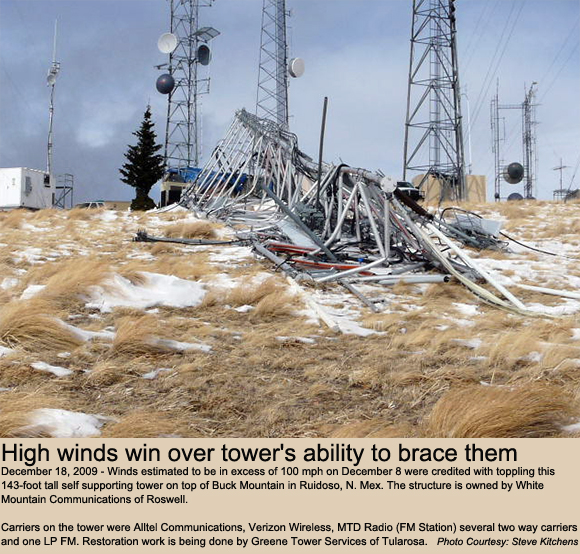
Alarmed buss bar helps to bust three thieves after brother implicates his brother
December 17, 2009 - Manatee County Florida deputies say they nabbed three copper thieves in the act while they were responding to an alarm coming from a cell phone tower on Erie Road in Parrish around 11 p.m. Tuesday. phone tower on Erie Road in Parrish around 11 p.m. Tuesday.
A removed copper buss bar triggered the alarm, and when officers arrived, they saw copper grounding bars, two pairs of gloves, bolt cutters and a duffel bag next to the cell tower.
A black Jeep was pulling out of the Copperstone development, just across the street from the cell tower and it was stopped by sheriff's officers. A K-9 unit dog located R. Eugene Walker hiding under a flatbed trailer that was about 100 feet west of the tower. He was dressed in all black and wearing gloves.
He said there were two others involved, they were driving a black Jeep, and their names were Ashley Rinehart and his brother Matthew Walker, both of Nokomis.
All three were arrested. It was found out later by authorities that the copper bars and grounding wire did come from the tower, and that the fence was cut in order to gain entry.
The 270-foot self supporting tower, built in 1997, is owned by American Tower Corp.
|
Services set for crew member Dirk Remington
December 17, 2009 - Services have been announced for Dirk M. Remington, 46, of 141 Columbia Street, Clyde, NY. who died unexpectedly on December 14, as the result of the collapse of a broadcast tower he was working on in the Town of Dix.
Family and friends are invited to call on Friday, December 18 from 2-4 and 7-9 P.M. at the Baris Funeral Home, 87 W. Genesee St. Clyde. Funeral services will be held on Saturday, December 19 at 10 A.M. in the Christ Community Church with Rev. Dana Rattray officiating.
In lieu of flowers, memorial contributions can be made to Dirk's children's educational funds, c/o of Mrs. Doris Remington, 6352 Huntington Dr., Zephyr Hills, FL 33542.
Surviving are his wife Valerie Adams Remington of Clyde; his daughters Denae Remington and Mariah Remington both of Clyde; his son Dustin Remington of Clyde; his parents Dale and Doris Remington of Zephyr Hills, FL; his sister Danielle (David) Carr of Wesley Chapel, FL; his brother Darvin (Maud) Remington of East Bethany, NY; his step daughter Shawna Adams of
Albany; and his step-grandchildren Hayden Adams and Pierce Adams.
|
One dead following New York tower collapse
UPDATE: December 15, 2009 - The Schuyler County Sheriff's Office has released the name of the tower erector who died when WRCE's 396-foot tower collapsed yesterday while a five-man tower crew was replacing guy wires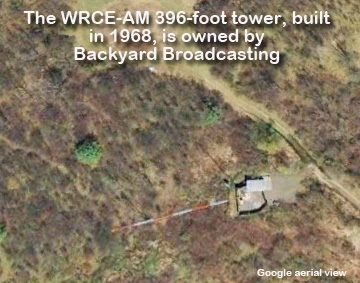 in the town of Dix, NY. in the town of Dix, NY.
Authorities say 46-year-old Dirk Remington of Clyde was attached to the tower while working on the guy wires at approximately 50-feet above ground level when the tower buckled and crashed to the ground. His four co-workers were not injured.
The tower crew was employed by Demand Communications Inc. of Owego.
On their web site, DCI says that all of their tower hands are certified by a leading national provider of climber training. They also state that they employ crew members that are certified in CPR and hazard communications.
DCI also conducts its own communications climbing program at a tower facility at their corporate headquarters.
The WRCE-AM tower, built in 1968, is owned by Backyard Broadcasting Elmira Licensee LLC, of Jacksonville, FL, according to FCC registration records. FCC records also indicate that at the identical latitude and longitude a 396-foot pole was constructed in 1975 and is owned by Northeastern Broadcasting, Inc. of Endicott, NY. Backyard Broadcasting is the parent company or WRCE-AM.
TIA 1019 to focus upon slippage
Schuyler County Sheriff's investigator Sergeant Matt Maloney told WirelessEstimator.com that the crew was in the process of changing out a guy wire when the accident occurred, and the tower appeared to have buckled at the point where Remington was working.
It will not be known why the accident occurred until a complete investigation is performed by OSHA.
However, guy wire slippage is a too frequent industry occurence and the concern is being addressed in the new construction standard, TIA 1019, expected to be released in Q4 of 2010.
Many times during construction, guys are pulled out and temporarily connected until they can be adequately secured in their final connection devices, sometimes with unfortunate results.
Sometimes connections that can slip must be used for efficient construction methods. In the event this is the case, guidelines are provided in the Standard for the following:
-- Methods to analyze the structure for a slippage event including impact factors to apply for either continuous slippage or instantaneous release are provided;
-- In the event a structure cannot safely handle the potential of guy slippage or other unequal structure forces guidelines on how and where to provide temporary backup guys is fully covered;
-- Annex E of the Standard, entitled "Wire Rope End Connections," will provide specific data on connections typically used in our industry that have been known slip as well as non-slip type connections. Acceptable methods of end termination of connections are covered;
-- An option to the use of temporary guy lines is given by adding in a backup system if slippage, that can be detrimental to the tower, can occur during a construction procedure.
* * * * * * * * * * * * * * *
December 14, 2009 - A tower technician died today after the tower he was tied off on collapsed in Schuyler County, NY.
Schuyler County Sheriff Bill Yessman said that there was a crew of five working on a guyed tower off County Route 16.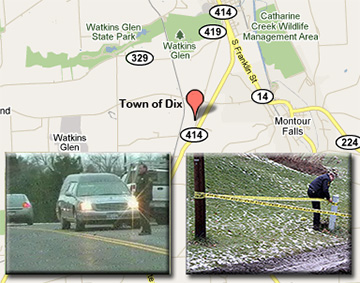
The sheriff's office got the call around 2:45 p.m., and at this point, details are limited.
WirelessEstimator.com will follow the tragedy of this year's fifth tower climber fatality.
One worker was tied off on the tower some distance up and the 396-foot-tall tower collapsed which resulted in a fatality at the scene, Yessman said.
The worker might have been in the process of changing out or performing maintenance on a guy wire at approximately the 60-foot level, authorities said.
Yessman says the first emergency unit responded within minutes, but there was nothing they could do. The Schuyler Hospital is less than a mile away from the broadcast tower site.
The tower was located about 100 yards off CR 16. The investigation is underway. Officials are withholding the victim's name until the family is notified.
Sheriff's investigators will return to the scene tomorrow morning along with representatives from the Occupational Safety and Health Administration.
The Montour Falls Fire Department, Schuyler County Volunteer Ambulance, Watkins Glen Fire Department and Schuyler County Emergency Management Office assisted at the scene.
The tower broadcasts the news/talk station WRCE-AM's 400-watt signal. According to FCC records, the structure is owned by Northeastern Broadcasting Inc. of Endicott, NY.
The details of the accident are not known, but the industry will be looking into whether ambitious project completion dates are to blame.
NATE cautions companies about unrealistic deadlines
Jim Coleman, Chairman of the National Association of Tower Erectors, recently said that demands are again being made to push crews to complete work, even if the pace requires a blind eye be turned to safety.
"At some point, this mode of operation will lead to tragedy. If you are involved in this industry, you know this to be true," Coleman said.
"The holiday season and the end of the year always seem to result in the imposition of unrealistic deadlines. They pose great potential for accidents for our employees. We must be diligent in enforcing safety practices and policies."
"Please take the needed steps to ensure that each of your employees understand that their safety must come first in all aspects of their job, and advise your customers that you will not endanger your crew for any reason, including being pressured to meet unrealistic deadlines," Coleman cautioned.
This year's total of five fatalities is the lowest since 2003 when WirelessEstimator.com began monitoring deaths within the industry.
|
Tower ice buildup seen as culprit for collapse
December 12, 2009 - Ice could be to blame for a tower collapse in Dawson 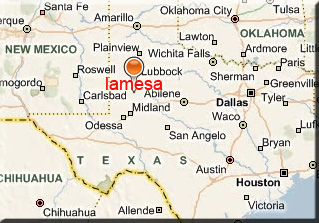 County, Tex. The 400-foot radio repeater tower fell Tuesday, south of Lamesa. It's owned by South Plains Communications out of Lubbock. County, Tex. The 400-foot radio repeater tower fell Tuesday, south of Lamesa. It's owned by South Plains Communications out of Lubbock.
Management said they think it collapsed due to a buildup of ice, but that has not been confirmed.
The tower fell before 70-mile per hour winds hit the area. Local, city and county communications had to relocate to another tower.
The structure, located at Hwy 137 and South Houston Ave., was built less than five months ago.
.
|
High winds kayo Oklahoma guyed tower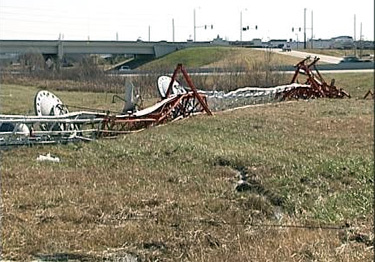
December 9, 2009 - Strong winds were apparently to blame for a downed guyed tower today in Broken Arrow, Okla.
The tower is owned by Public Service of Oklahoma and is located near Lynn Lane and U.S. Highway 64.
The company believes high winds caused the guy wires to snap, bringing down the 26-year-old tower.
The tower is used by PSO for internal communications.
|
Tower jumper ends his life after experiencing three seconds of an extreme sport on a Verizon tower
December 6, 2009 - Authorities say a man died after parachuting from a cell phone tower at about 9:45 P.M. Friday after hitting high-voltage power lines at the site near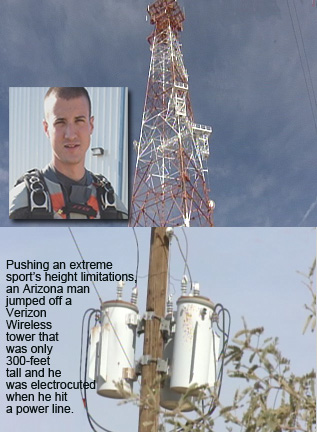 Casa Grande, Ariz. Casa Grande, Ariz.
Pinal County Sheriff's Lt. Tamatha Villar says 23-year-old Darrell Dunafon of Queen Creek and two friends broke into a cell tower compound about 30 miles south of Phoenix on Friday night and were parachuting off the 300-foot-tall four-legged self supporting tower.
Dunafon's parachute tangled in nearby 12,000-volt power lines and he was electrocuted.
Villar says the two friends called for help, and rescue crews turned off the power and cut Dunafon down. He had a slight pulse but was pronounced dead at a hospital in the nearby town of Casa Grande.
The trio was BASE jumping, an acronym for parachuting from Buildings, Antennae, Spans and Earth.
The two friends admitted to investigators they knew they were trespassing and that the power lines were nearby, Villar said. They were not arrested, but a report will be sent for review by local prosecutors.
The tower, constructed in 2004, is owned by Gila River Cellular General Partnership of Alpharetta, Ga.
Gila River Telecommunications, Inc. is a 25% owner of the Gila River Cellular General Partnership with Verizon Wireless, serving rural areas in Arizona . The service area includes a portion of the Interstate 10 corridor between Phoenix and Tucson, as well as all of Pinal and Gila counties.
BASE jumpers risk their lives whenever they jump from a structure due to unexpected wind currents and other uncontrollable factors, but jumping from a 300-foot tower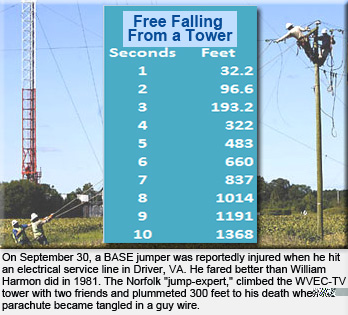 courts a near death experience every time. courts a near death experience every time.
Free falling off of a tower starts at 32.2 feet per second, but it increases an additional 32.2 feet every second until maximum velocity is reached at 177 feet per second.
Therefore, Dunafon had no more than three seconds to ensure that his parachute's canopy was fully deployed.
Tower climbers have oftentimes discussed how long they would have before they hit the ground if they fell from a 1,000-foot tower. For parachutists and those technicians not employing 100% fall protection, life's remaining seconds total less than eight seconds.
On September 30, a parachutist in Driver, Va. jumped from a 1,000-foot guyed tower, missing the guy wires, but striking a power line and leaving 500 homes without power. Witnesses say he appeared to have been injured, but was carried off by another two BASE jumpers.
|
Pennsylvania police fear unauthorized climber 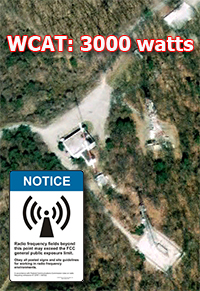 might need medical attention might need medical attention
December 5, 2009 - Springettsbury, Pa. police are looking for the individual that climbed country music station WCAT's 387-foot guyed tower sometime this week and tied a maroon bed sheet to the antenna.They're concerned that the climber might add new meaning to Mel Tillis's lyrics in Burning Memories.
The RF from the tower can cause medical issues and internal injuries, and the individual might need medical help, said Spingettsbury Township Police Lt. Scott Laird.
Lock out/tag out procedures are called for when professional broadcast workers perform service on the antenna.
Anyone with information is urged to call Springettsbury Township Police at 717-757-3525.
The station and tower are owned by Citadel Broadcasting.
The effective radiated power of WCAT is 3,000 watts. If the climber headed down the highway to WNNK's "Hot Adult Contemporary" tower, he would have been exposed to an ERP of 20.5 kW.
In the case of a person in an RF field, the body acts as a dielectric. If the power in the RF field exceeds 10 milliwatts per centimeter, a person in that field will have noticeable rise in body temperature. The eyes are highly susceptible to dielectric heating.
Although the tower site was secured and Citadel had a warning sign that the area exceeded the general public exposure limit, it was ignored by the climber who scaled the fence.
There are no known national public service campaigns educating unauthorized climbers about the dangers of RF radiation from antennas on towers.
Although it might be an excellent campaign for the NAB, CTIA, PCIA or other associations to champion, industry insiders believe that it would just elevate unfounded concerns about RF exposure from cell phone antennas and other emitters on towers.
"Any ERP safety concern is in a restricted compound, on the tower, or near the antenna," said a North Carolina broadcast engineer. "The public, unless they're foolish enough to break into a site and climb a tower is never at risk, but you'll never convince the alarmists no matter how much documentation you provide."
|
Construction standard delayed, but Revision G addendum expected this week
December 1, 2009 - The industry's new national construction standard, ANSI/TIA-1019, will not be released until the fourth quarter of 2010. However, Addendum 2 of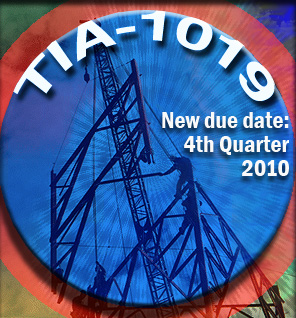 the ANSI/TIA-222-G Standard is expected to be released this week, according to Brian Reese, P.E. of ReliaPOLE Inspection Services Company, and Chairman of the TIA TR14.7 Committee. the ANSI/TIA-222-G Standard is expected to be released this week, according to Brian Reese, P.E. of ReliaPOLE Inspection Services Company, and Chairman of the TIA TR14.7 Committee.
Reese was re-elected to head the committee for another two-year term on November 10 at a meeting in Pittsburg, Pa.
Re-elected to serve as Vice-Chairman and Secretary for another two-year term was John Erichsen, P.E, S.E., of EET, L.L.C.
Addendum 2 will include minor editorial changes and refinements based on recent changes in the reference standards used as the basis for Revision G. Clarifications have also been made in some sections based on user inquiries for interpretations and the subcommittee's desire to provide additional clarification on the standard.
In addition, the subcommittee voted to send ANSI/TIA-222 G “Structural Standard for Antenna Supporting Structures and Antennas” and ANSI/TIA-222 G Addendum 1 for reaffirmation ballot. Revision G was approved August 2, 2005 after a public ballot process and was effective January 1, 2006. The 222 Standard is reaffirmed or revised every five years.
Since many jurisdictions have not adopted Revision G yet, it was decided that instead of providing a Revision H, an Addendum 3 will be issued. Considerations for the addendum include small wind turbine structures, fatigue, and dynamic gust response.
The Structural Reliability Task Group, chaired by Bill Griswold of IETS discussed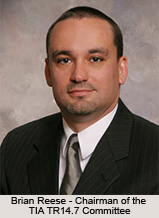 base plate design and guyed tower anchor rod corrosion. base plate design and guyed tower anchor rod corrosion.
An update on ANSI/TIA-1019, “Structural Standards for Steel Gin Poles Used for Installation of Antenna Towers and Antenna Supporting Structures” was provided to committee members.
First released in 2004, the standard was intended to provide minimum design criteria for the design and use of steel gin poles.
The standard is being updated to provide minimum loading requirements for towers under construction, alteration or maintenance, and address specialized equipment such as gin poles, frames, hoists and the temporary supports necessary to safely complete those tasks, along with the design requirements for a gin pole.
It will consider special construction requirements and processes commonly used when removing an existing antenna from an existing tower, or removing all or a portion of an existing tower.
The revised standard will be entitled “Structural Standards for Installation, Alteration and Maintenance of Antenna Supporting Structures and Antennas.”
The updated material in the revised standard will be presented at the Orlando NATE conference in February.
The standard was expected to be released this year, but editorial changes and ANSI review will require additional time, Reese said.
.
|
Industry applauds FCC's shot clock ruling for a timely review of tower siting and co-locations
November 19, 2009 - The FCC has adopted a declaratory ruling establishing a shot clock for tower siting applications. The commission determined that state and local governments must review collocation applications within 90 days and all other tower  siting applications within 150 days of submission. (View Ruling) siting applications within 150 days of submission. (View Ruling)
“This action will assist in speeding the deployment of next generation wireless networks while respecting the legitimate concerns of local authorities and preserving local control over zoning and land use policies,” the FCC stated.
"This sounds like a win, win, win to me," commissioner Michael Copps said at the FCC's monthly meeting. During a keynote speech at the CTIA Wireless IT & Entertainment show in San Diego in October, Genachowski said the issue was one that was "ripe for action."
The vote was 5-0 for the item.
The decision is meant, in part, to help speed the rollout of wireless broadband, including services making use of the re-auctioned 700 mHz spectrum reclaimed from broadcasters in the DTV transition.
Commissioner Robert McDowell, who said the item struck an elegant balance, said he hoped that the decision would allow wireless companies calling for lots more spectrum to get more efficiencies out of the spectrum they already have. spectrum to get more efficiencies out of the spectrum they already have.
The ruling reflects a Congressional mandate that requires that state and local authorities act “within a reasonable period of time” on requests for tower siting. The commission noted that creating a wireless, nationwide broadband system “will require new physical networks, including many new towers.”
Most municipalities deal with tower applications “in a timely fashion,” the agency said, but it found several instances of “unnecessary delays.”
“One challenge mobile operators face is getting timely zoning approvals from state and local officials before building towers or deploying new equipment,” said FCC Chairman Julius Genachowski. “For example, at the time the petition was filed, of the 3,300 pending zoning applications for wireless facilities, over 760 had been pending for more than a year and 180 had been pending for more than three years. There is evidence that in certain jurisdictions the tower siting process is getting longer, even as the need for more towers and for timely decisions is growing.”
Failure to adhere to the timeframes could involve the courts. The FCC noted that if a “jurisdiction ‘fails to act’ on the application within this reasonable time period, applicants may file a claim for relief in court within 30 days of the failure to act,” the commission said. “The court will then decide what action to take based on all the facts of the case.”
The ruling also enjoins state and local governments from denying a siting application from one wireless provider on the grounds that another is serving the area. It also denies a request from the CTIA, a wireless industry lobby, to prevent municipalities from requiring variances or waivers for tower siting.
CTIA, which spearheaded the drive for a shot clock, said the FCC had provided "much-needed certainty" to the process. "We sincerely appreciate the commission and the Chairman for quickly acting to fulfill this promise," said CTIA President Steve Largent in a statement.
AT&T also appreciated the Commission's decision. "In approving this important reform today, Chairman Genachowski and the commission have provided tremendous support for the effort to bring more mobile broadband to consumers," said Senior VP Robert Quinn, also in a statement.
But the wireless carrier would have liked more. "The Commission's action today, while not giving the industry all that was requested, provides a path to resolve zoning issues related to siting of towers much faster than the process that exists today," AT&T said in a statement.
|
Automated emergency action plan will cut through confusing data and preparation time
November 16, 2009 - The U.S. Office of Management and Budget found in 2001 that it took approximately two minutes to post emergency telephone numbers at a job 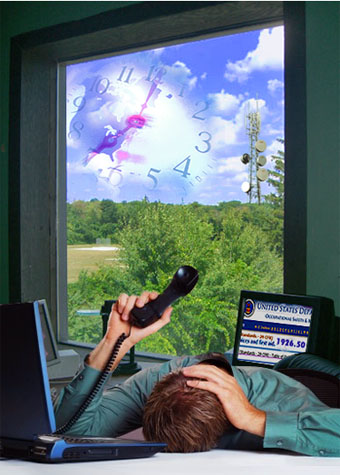 site. site.
Project administrators and managers will quickly agree that posting the information isn't a burden, finding the nearest hospital and police department and other required information is, and it can oftentimes take up to 20 minutes or more on each project to prepare their emergency correspondence plan.
In addition, they say, the accuracy can be questionable when there is a heavy reliance upon Google and online phone directory searches.
In their safety and health regulations for construction, an OSHA requirement states that in areas where 911 is not available, the telephone numbers of the physicians, hospitals, or ambulances shall be conspicuously posted.
Best practices of most companies include a list of company personnel that will be on site as well as their first aid and rescue training capabilities. Directions to the nearest emergency treatment hospital, latitude and longitude, the work being performed and additional information is also provided.
WirelessEstimator.com has teamed with many of the country's leading safety officials and construction managers to review the many jobsite emergency action plans available and provide one that will meet their needs.
The interactive form is currently being beta-tested and will be available in December.
Once users enter the jobsite address, they will receive the address and phone number of nearest hospital offering emergency medical treatment, directions to the hospital and the nearest fire department as well as local police department information. The jobsite latitude and longitude will also be provided.
With the convenience of instant Google mapping and aerial views of the jobsite, the intuitive form will quickly allow users to input additional information and print it out, and easily email it in a PDF form from any computer.
|
Reward being offered for capture of arsonists responsible for torching $230,000 crane
November 13, 2009 - Å $5,000 reward for information leading to an arrest of those involved in setting fire to a crane on Nov. 7 on East Bakerville Rd, in Waltonville, Ill. is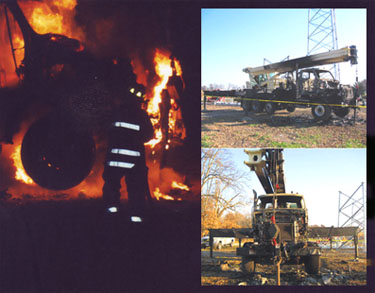 being offered by Capital Tower & Communications, Inc. of Waverly, Neb. being offered by Capital Tower & Communications, Inc. of Waverly, Neb.
According to Capital's director of operations, Dave Dubas, the Jefferson County Sheriff’s Office responded to the cellular tower construction site after a report from a local farmer in the rural area that the crane at the site was on fire.
The fire was extinguished, but extensive damage was done to the 33-ton 1400 Series National Crane. The boom truck is valued at $230,000 and is a total loss, Dubas said.
Capital is currently stacking a 250-foot self supporting tower for a mobile carrier.
The tower construction company is offering a $5,000 reward for information resulting in the arrest of the arsonist, according to information from Jefferson County Crime Stoppers.
Anyone with information concerning who started the fire or was involved in the arson is urged to call Detective John Kemp at the Jefferson County Sheriff's office at 618-244-8004. the Mount Vernon Police Dept at 618-242-2131 or Jefferson County Crime Stoppers at 618-242-TIPS (8477).
If you share information with Crime Stoppers, you do not have to leave your name or telephone number and you can remain anonymous. Any information that leads to the arrest may make the caller eligible for a cash reward.
|
Ohio tower painter's condition improves after fall from North Carolina Tower
UPDATE: November 19, 2009 - Although Christopher Guy will have to undergo a rehabilitation period for injuries he received when he fell from a tower on November 4, the tower painter's condition has improved, according to a hospital spokesperson.
The fall is being investigated by the N.C. Occupational Health and Safety Division.
Guy is employed by Eastern States Tower Services of Lisbon, OH. The limited liability company was formed in 2003 by Walter Macuich.
A representative of NCOSH informed WirelessEstimator.com that in addition to the investigation of Eastern States Tower Service, LLC, there were separate investigations involving Cellco Partnership dba Verizon Wireless, Lazer Construction Company, Inc. and American Towers, Inc.
A compliance officer said Eastern States Tower Services' physical address is in East Palestine, OH.
The company's web site identifies that "The owner started doing cell tower work over 15 years ago with his brothers. 5 years ago he went out on his own. He started with 1 truck and a couple of guys and has grown to over 7 crews."
They also state, "Our employees are all Comtrain certified and all have CPR First Aid Training."
Guy reportedly broke both legs and a kneecap in the fall, but did not suffer any head trauma. Macuich did not return a call to comment upon the accident.
- - - - -
November 6, 2009 - A tower painter who fell from a cell phone tower Wednesday near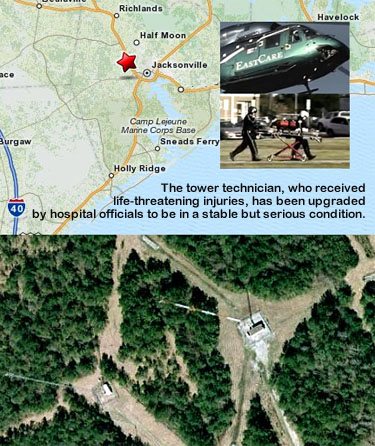 Jacksonville, N.C. is recovering at Pitt County Memorial Hospital, authorities said. Jacksonville, N.C. is recovering at Pitt County Memorial Hospital, authorities said.
The worker was at the 300-foot level of the 413-foot guyed tower, but officials are not sure how much of that was free fall, according to Onslow County Emergency Management.
They believe it is doubtful that he fell the full distance and still survived.
The Ohio worker, who has not been identified, fell from an Verizon tower on Pony Farm Road at around 2 p.m.
EastCare flew the injured worker to the hospital.
The painter is in serious, but stable, condition, stated hospital officials.
According to Norman Bryson, Director of Emergency Services & Homeland Security for Onslow County, the worker was painting the tower when he suddenly fell.
Bryson said that the paint crew is still on site and OSHA will be investigating.
He said that his department did not obtain the name of the employer of the injured worker and HIPAA rules prevented him from providing additional information.
WirelessEstimator.com will provide additional details about the accident when they are released by authorities.
|
Extreme sport jumper is exposed to extreme RF
November 5, 2009 - Police have not captured or identified a parachutist who climbed a TV broadcast tower in Farmington, Conn. and jumped off in a red, white and blue parachute yesterday morning.
A red Ford Taurus with Ontario plates that police found parked near the property was towed. The owner reportedly spoke with police when he claimed the car at the towing company and admitted to parachuting in Canada, but denied jumping from the 1,399-foot tall guyed tower.
Farmington police searched the Taurus and a relative's house in Unionville where the Canadian was staying but did not find any evidence linking him to Wednesday morning's incident.
"It's insane, what he did," said Arnold Chase, owner of Communications Site Management to the Hartford Courant. The company owns and manages the tower with tenants Fox 61, WTXX, as well as CPTV. In addition, a number of other tenants use the tower, including WRCH-FM, police departments and other communication companies.
"Normally, when any maintenance is done on the tower, all the power is turned off," Chase said. "This jumper climbed our antenna while it was radiating at full power."
Being in immediate proximity to a radiating antenna is "analogous to being inside a microwave," Chase told the Courant.
Fox 61 is registered as a 5000 kW station. Microwave ovens exist in the 400 to 1200 watt range.
Chase said that the compound is one of the most secure sites possible and "this guy really put some effort into getting in."
He also said that although the TV antenna's RF could cause injuries to the parachutist, the FM emitter was even more powerful and could cause brain, eye and testicular heating that could result in illnesses for the climber at a later date.
Police went to the transmitter site off Route 6 about 5:30 a.m. after an alarm was activated. Officers didn't find anything during their initial investigation, and could not see the parachutist on top of the tower.
They were called back after assistant site manager Joseph Legere reported that he witnessed the parachutist jump from the east side of the tower.
On September 30 (below), a parachutist in Virginia was reportedly injured when he jumped from a tower and landed on an electrical line servicing the area.
-
|
Feds: S.C. pilot made careful plans before crash
November 5, 2009 - A preliminary report on a South Carolina plane crash last month that killed four says the pilot made meticulous preparations for the flight.
The report from the National Transportation Safety Board says Peter Radding made several practice landings and takeoffs at night in the days before the crash.
Investigators also found e-mails between Radding and the passengers with the weights of items being taken on the plane and discussions about what could be left behind if the cargo was too heavy.
One of the fatalities was Randy Hargenrader, 55, a well-known and respected designer of alarm monitoring systems used by SBA, Crown Castle International and other tower companies.
Hargenrader was also an accomplished pilot.
|
Misdialed number leads to angry texts, shooting
October 28, 2009 - Georgia police said a misdialed number led two strangers to trade hostile calls and text messages before arranging a meeting where one shot the other. trade hostile calls and text messages before arranging a meeting where one shot the other.
Savannah-Chatham police spokeswoman Veda Lamar Nichols said that one man, 22, faces an aggravated assault charge. The 22-year-old suspect was jailed after a 24-year-old man was shot in a CVS parking lot around 2:30 a.m. yesterday.
Nichols said the victim was taken to Memorial University Medical Center in serious condition. She said the two didn't know each other but began arguing through phone calls and text messages after a misdialed number and arranged to meet in the store's parking lot.
The suspect was taken to the Chatham County jail. Nichols said his vehicle was damaged during the incident.
|
Antenna stretch will allow Japan to retain title to world's tallest self supporting broadcast tower
October 28, 2009 - On the verge of being stripped of the title of being the world's tallest self supporting communications tower upon completion, the erectors of the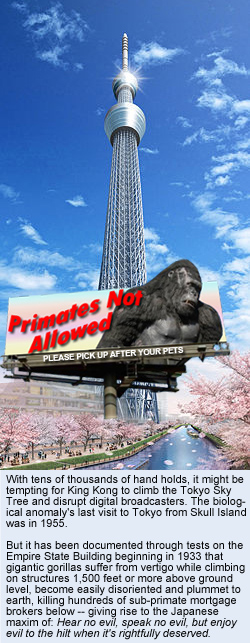 Tokyo Sky Tree tower in Japan said that they will increase the tower top antenna another 79 feet to retain the tall tower trophy. Tokyo Sky Tree tower in Japan said that they will increase the tower top antenna another 79 feet to retain the tall tower trophy.
Initially designed to reach 2,001 feet, the increased height to 2,080 feet was necessary to beat Guangzhou, China's 10-foot taller tower TV tower that is almost topped out.
The Sky Tree structural design will enable it to support a height of 2,100 feet, allowing another 20 feet if Shanghai tries to take back bragging rights.
The Sky Tree is scheduled to be completed in the spring of 2012 and the builder, Tobu Railway, says the new plan will neither delay the planned opening nor increase construction costs which stand at $717 million.
As well as providing digital broadcasting, the tower will have public observation decks and restaurants, and will be lit up every other night with different sets of lights.
"It will be beautifully decorated with a limited amount of lights, in consideration of the environment," lighting designer Hirohito Totsune said.
Construction work is well under way, close to Oshiage Station in Tokyo's Sumida Ward, with the tower's triangular base already completed. The company's website indicates that work has reached a height of 570 feet. The completed structure will have graceful curves that are meant to represent the blade of a samurai sword and other features found in traditional Japanese architecture.
An observation platform at a height of 1,148 feet will mark the point at which the structure changes from a triangular shape to a cylinder, which is better able to withstand very strong winds. A central shaft, made of reinforced concrete, draws its design from the five-tier pagodas that have dotted the Japanese landscape for hundreds of years -- and are remarkably effective in withstanding the potentially devastating effects of earthquakes.
A second observation deck will be at 1,476 feet above Tokyo, after which the remainder of the tower will rise to a height of 2,080 feet.
|
City's $30 million proposal seen as "scientifically naïve"
New York City will monitor all cell site antenna RF levels if proposed legislation passes
October 23, 2009 - New York City's recent introduction of legislation that would require the Department of Buildings to monitor the radiofrequency electromagnetic 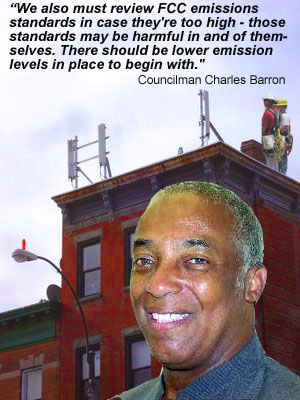 fields emitted by cell site antennas would help legislators to turn down proposed cell sites, according to the bill's sponsor, Councilman Vincent Gentile. fields emitted by cell site antennas would help legislators to turn down proposed cell sites, according to the bill's sponsor, Councilman Vincent Gentile.
If passed, however, it could help to assist in deflecting residents' health concerns if considerably lower than allowable levels of RF are observed.
"Measurements would become public records," said a major mobile carrier asset manager who says his company's sites are operating at considerably lower than the allowable thresholds. "This legislation is designed to get votes and create another bureaucracy in the already bloated DOB," he said.
"They should first consider having a third party tester do a random sampling of sites and identify if any of them exceed federal requirements. If they come up empty-handed, let the public know and end this nonsense," he said.
The bill would require the DOB -- which issues permits for the antennas -- to monitor the radiofrequency radiation emitted by the cell phone antennas in the city every six months, reporting on those whose emissions exceed the federal guidelines.
The president of the New York State Wireless Association, Douglas Dimitroff, believes Gentile's bill is at odds with existing federal regulations and will obstruct the industry's growth. industry's growth.
"The FCC is responsible for regulating RF emissions for licensed carriers and the federal Telecom Act of 1996 prohibits state and local governments from further regulating sites based on RF emissions," said the Buffalo, N.Y. attorney who specializes in telecommunications law.
"Adding unnecessary regulatory complexity to a highly competitive industry will only hinder the investment of millions of dollars to expand and improve cellular services that can grow jobs and the economy," said Dimitroff who is also active in the New York State Telecommunications Association as well as the Site Owners and Managers Division of the PCIA - The Wireless Infrastructure Organization.
Dimitroff said this bill is an issue of significant concern to the NYSWA's membership and its regulatory committee will be taking a closer look at its ramifications.
Please see: FCC accused of giving carriers a free ride
.
|
Hark Systems founder passes in plane crash
UPDATE: October 23, 2009 - There will be a gathering of family and friends on Sunday, October 25 from 6-9 p.m. at Dyal's Funeral Home, 303 S. Main St., Summerville, SC. James Randolph “Randy” Hargenrader is survived by his wife, Shellie Cantrell . Randy was born June 29, 1954 in Oil City, Pennsylvania, son of Mildred Spence of Oil City, Pennsylvania and the late Richard Kenneth Hargenrader. He was a graduate of Oil City Senior High School, Class of 1972. He served in the United States Navy for 6 years. He was CEO with Hark Systems Incorporated and a member of Summerville Church of Christ.
Surviving in addition to his wife and mother are:
Two sons: James Andew Hargenrader and his wife Carey of Rocky Mount, Virginia, Aaron Michael Hargenrader and his wife Tiffany of West Ashley, Brothers and sister: Richard J. Hargenrader of Dallas, Texas, Annette M. Hargenrader of Erie, Pennsylvania and William L. Hargenrader and his wife Angela of Oil City, Pennsylvania.
* * *
October 21, 2009 - Randy Hargenrader, of Summerville, SC, president and founder of Hark Systems, a leading wireless industry supplier of alarm monitoring equipment, passed away early this morning when the small plane he was a passenger in crashed shortly after departure in South Carolina. The accident also killed three of his friends that were heading to an amateur radio convention in the Bahamas. accident also killed three of his friends that were heading to an amateur radio convention in the Bahamas.
Authorities say the plane climbed above the trees to between 100 and 150 feet in the air before something caused it to make a sharp U-turn and then crash into a wooded area near the Summerville airport, not far from the coast.
The twin-engine Piper PA-23, which seats six and was built in 1976, crashed around 6:20 a.m. and was engulfed in flames when firefighters arrived at the scene in a rural area northwest of Jedburg, Dorchester County Administrator Jason Ward said. Investigators were hindered by the flaming wreckage.
Dorchester County Coroner Chris Nesbit identified the other three who died in the crash as the pilot and plane's owner, Peter Radding of North Charleston, and passenger Edwin Steeble of Summervile in addition to Dallas Carter, of Laurel, Del.
The men were flying to Fort Pierce, Fla. to pick up two other passengers, and then on to the Bahamas for the convention, Nesbit said.
Radding had been flying for 40 years, and Hargenrader was also a licensed pilot, he said.
Hargenrader, 55, was a well-known and respected designer of alarm monitoring systems used by SBA, Crown Castle International and other tower companies. His company's products are also carried by major wireless industry distributors.
Oftentimes a guest panelist at industry trade shows, Hargenrader was eager to share his knowledge.
He also actively assisted WirelessEstimator.com in offering the tower installation community the opportunity to view the industry's first real time viewing of the erection of a 1,500-foot tall broadcast tower in Deland, Fla.
Michael Johnson, President of PRIMUS Electronics said he was truly shocked and saddened at the tragic news. "In all of my dealings with Randy, he has conducted himself with total class and professionalism. He brought a unique friendliness into his business dealings. I am sure I share with many others my sorrow for having lost this industry member, and he will be missed," said Johnson.
"TWR Lighting wishes to express our sincerest condolences to the family of Randy Hargenrader. Randy was a true telecom industry professional and leading innovator in tower site monitoring technology. His spirit and commitment to the industry will be missed as much as his friendship," said TWR's president, Ken Meador.
"I felt honored to have Randy as a friend for many years," said WirelessEstimator.com's president, Craig Lekutis. "Randy and I talked yesterday afternoon for over an hour and agreed upon the cure for all the world's ills, discussed home improvement projects we were both undertaking, and promised to talk again next week, never considering how fragile life can be. Alongside the industry, my condolences go out to his family and friends. He'll be sadly missed, but joyfully remembered."
Funeral services are pending and will be announced when available.
|
Bias found in some cell phone cancer studies according to US/Korean review
October 20, 2009 - A group of South Korean and American researchers has found studies on whether mobile phones can cause cancer, especially brain tumors, vary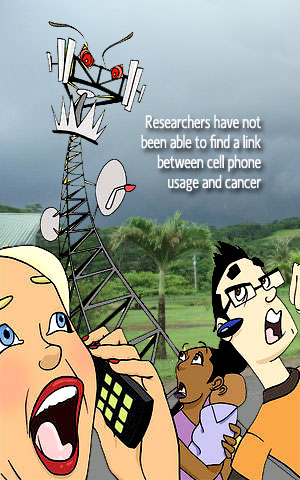 widely in quality and there may be some bias in those showing the least risk, researchers reported. widely in quality and there may be some bias in those showing the least risk, researchers reported.
So far it is difficult to demonstrate any link, although the best studies do suggest some association between mobile phone use and cancer, the team led by Dr. Seung-Kwon Myung of South Korea's National Cancer Center found.
Myung and colleagues at Ewha Womans University and Seoul National University Hospital in Seoul and the University of California, Berkeley, examined 23 published studies of more than 37,000 people in what is called a meta-analysis.
They found results often depended on who conducted the study and how well they controlled for bias and other errors.
"We found a large discrepancy in the association between mobile phone use and tumor risk by research group, which is confounded with the methodological quality of the research," they wrote in the Journal of Clinical Oncology.
Research has failed to establish any clear link between use of the devices and several kinds of cancer.
The latest study, supported in part by the U.S. Centers for Disease Control and Prevention, examined cases involving brain tumors and others including tumors of the facial nerves, salivary glands and testicles as well as non-Hodgkin's lymphomas.
It found no significant association between the risk of tumors and overall use of mobile phones, including cellular and cordless phones.
Myung's team said eight studies that employed "high quality" methods to blind participants against bias found a mild increased risk of tumors among people who used mobile phones compared with those who never or rarely did.
An increased risk of benign, not malignant, tumors was also found among people who used the phones for a decade or longer.
The "high quality" studies were funded by the Swedish Work Environment Fund, the Orebro Cancer Fund and the Orebro University Hospital Cancer Fund, Myung's team said.
The "low quality" studies, which did not correct for bias, found no link, or found that people who used mobile phones faced lower risks of tumors than people who rarely or never used the phones. Myung's team said some of these studies were funded by the Global System for Mobile Communication Association and the Mobile Manufacturer's Forum.
Myung's team suggested those results could be marred by random errors and bias because of the quality of the methods.
Overall, the studies examined were not broad enough to shed light on whether mobile phone use could cause tumors. Myung's team said larger studies of a type called cohort studies are needed to answer that question.
Such studies follow a group of people who share a characteristic, in this case cellphone use, and compare them with other groups over time.
The only cohort study published to date showed no association between mobile phone use and tumors. But the study, conducted in Denmark, relied on telephone subscriptions and did not evaluate actual exposure to mobile phones.
The use of cell phones and other cordless phones has increased dramatically over the last decade, with an estimated 4.6 billion users today, according to the United Nations International Telecommunication Union. There have been concerns the radiation emitted by the phones may cause health problems, but so far there is no proof, and the debate continues.
|
Colorado State Wireless Association kicks off its inaugural luncheon this Thursday
October 19, 2009 - The latest state wireless industry association, The Colorado Wireless Association (COWA), has announced its formation and will hold its inaugural luncheon and launch event this Thursday, October 22, at the Hilton Garden Inn – Denver Tech Center in South Denver, Colo. There will also be an evening social mixer at the Cowboy Lounge in downtown Denver. During both events, COWA will be coordinating a charity fundraiser for the local chapter of Ronald McDonald House Charities. Wireless Association (COWA), has announced its formation and will hold its inaugural luncheon and launch event this Thursday, October 22, at the Hilton Garden Inn – Denver Tech Center in South Denver, Colo. There will also be an evening social mixer at the Cowboy Lounge in downtown Denver. During both events, COWA will be coordinating a charity fundraiser for the local chapter of Ronald McDonald House Charities.
Luncheon speakers will include Michael Fitch, President and Chief Executive Officer of PCIA - The Wireless Infrastructure Association, Nancy Chrisman, Director of the State Wireless Association Program and Membership for PCIA, and keynote presenter, Keith Paglusch, Executive Vice-President at Open Range Communications.
Founding Board Members and Officers of COWA include, President, Craig Pruett, Terracon Consultants, Inc.; Vice President, Nate Foster, Open Range Communications; Secretary, Juliette Hamer, T-Mobile Towers; and Treasurer, Randy West, AT&T Mobility.
Pruett said, “We are very excited to launch the Colorado Wireless Association and to promote the advancement of the wireless industry in Colorado. We look forward to providing a collaborative platform for issues at the state and local level and invite our colleagues to join us in our initiatives.”
The Colorado Wireless Association is a non-profit professional association dedicated to being the voice of the wireless industry in the Centennial State. Its members represent the creative talent and energy of wireless carriers, tower companies, network developers, and their supporting vendors. Its mission is to educate communities and the public about wireless industry news and practices. COWA will cultivate ethically responsible relationships between the wireless industry and the local communities it serves.
Visit the COWA website at www.cowireless.org in the near future for member registration and to provide information about association activities. There is no cost to be a COWA member. Information and registration for the launch event, social mixer, and charity fundraiser can be found at: http://coloradowirelessassociation.eventbrite.com.
|
Ham mast install results in death of Florida family
October 13, 2009 - Police in Florida say a mother, father and their 15-year-old son died after being electrocuted while putting up a ham radio antenna in their Palm Bay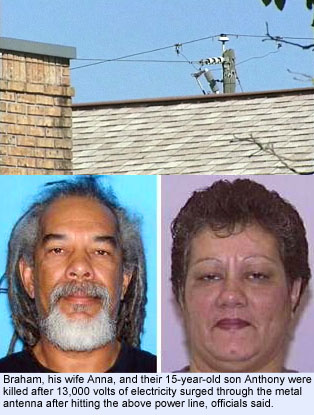 home last night. home last night.
Police say Melville Braham, 55, was putting up the antenna on a 50-foot mast at about 8:30 p.m. for his mother, who uses the radio to talk with family members in Jamaica, when the tower fell across power lines.
Braham, his wife Anna, 49, and their 15-year-old son Anthony were killed after 13,000 volts of electricity surged through the metal antenna, officials said.
It happened in an instant,” said Palm Bay Fire Marshal Mike Couture in a statement released overnight. “It is an unfortunate set of circumstances that led to the most tragic result.”
A 17-year-old male was also on the roof helping the Braham family but was not hurt. The Braham’s daughter, Melissa, 21, was inside the home at the time and not injured, police said.
Florida Power & Light Co. crews responded to the scene and shut off power in the area while authorities collected evidence and documented the scene, police said.
Federal Communications Commission records do not show that any of the victims are licensed amateur radio operator. They do, however, show a license issued to Barbara V. Tenn at the residence where the electrocutions occurred.
According to the records, Tenn, 76, obtained a technician class license in March and upgraded it to a general class license in April.
“Based on the size and weight of the antenna, they just lost control of it and it slid onto the power line,” said Couture. “This wasn’t something they should have been doing at night.”
Every year, ham radio operators or friends who assist them in installing equipment either fall to their death or are electrocuted. The internet is full of photographs of operators unsafely hanging from their towers without any fall protection equipment.
In June, a 57-year-old Niles Michigan man suffered a fatal fall from a radio tower at a ham radio demonstration in Watervliet.
|
Proposed 1,500-foot self supporting tower enjoyed a stealth-like entrance and exit
October 8, 2009 - Tower site developer John Maguire's proposed 1,500-foot tower in McHenry County, Il. was to be the world's tallest self-supporting tower (without a public observation deck), but the plan has been grounded after the FAA reportedly stood in the way, stating that the tower would be a danger to Lake in the Hills Airport's aircrafts. been grounded after the FAA reportedly stood in the way, stating that the tower would be a danger to Lake in the Hills Airport's aircrafts.
On March1, 2008, Mc Henry County Blog broke the story that Maguire, President of Oklahoma-based BMB Communication Management LLC held a private meeting with McHenry County College officials to entice them into inking a deal that could provide MCC with $6 million if he could purchase 3.6 acres of the college's property so that he could build the new broadcast tower.
According to blogger and retired Republican state representative Cal Skinner, then MCC President, Walt Packard, kept him from photographing any more exhibits of Maguire's presentation when he wrapped the boardroom's wire mesh safety windows in plastic before continuing with the tower proposal meeting.
On February 10, 2009, WirelessEstimator.com interviewed Maguire about the epic structure that was expected to cost in excess of $24 million to construct. A total of 3.6 acres is what Maguire believed would be necessary for the tower's and compound's footprint. Preliminary design, he said, identified the leg to leg distance at 136 feet.
"It is expected," Maguire said, "that the structure will require between six to eight million pounds of steel. At $1.25 a pound, the steel alone is going to cost $10 million."
At a February 18 public meeting, preliminary design drawings and other details were provided to the MCC Board and an agreement was reached (See: 58-page presentation) . However, BMB placed a number of approval requirements in the contract that would allow it to walk away if they were not achievable.
The primary hurdle was to get the FAA Determination of No Hazard.
The FAA had raised concerns because the proposed tower would be in airspace
that pilots at Lake in the Hills Airport use if they miss their approach to a landing
and have to pull up and try again, Maguire said.
He said he believed the airport could change its procedures and order pilots to circle in another direction.
But his persuasive powers that worked with college officials couldn't sway the FAA.
During a MCC public board meeting in late August, the board was informed by its attorney that local BMB attorney Thomas Zanck had called with regard to BMB's broadcast tower.
Zanck had said that BMB's tower experts had determined that the FAA would likely not approve of what BMB had proposed, but according to board members, little else was made available to them.
"We knew going into this (was unlikely to be approved)," board member Barbara Walter said. "There is no sense in going on. I'd just let them out," she said, according to Skinner who was at the meeting.
"Let them do their thing and let them out of it," Board President George Lowe added.
Although there were due diligence expenses for BMB, their only obligation to MCC was to relinquish their $2,500 earnest money deposit.
Maguire has not replied to numerous emails regarding the tower. Zanck said he would not be comfortable discussing the FAA issue, but would contact his client and let him know of our interest.
|
Industry applauds FCC Chairman's desire to cut red tape and speed up the tower siting process
October 7, 2009 - FCC Chairman Julius Genachowski endorsed two CTIA initiatives in his opening keynote at CTIA Wireless I.T. & Entertainment today in San 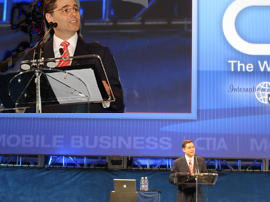 Diego, Calif. Diego, Calif.
Genachowski's address was interrupted once by audience applause when he committed to the industry that the FCC will move forward with a process to speed tower siting approval.
Steve Largent, president and CEO of CTIA, also commended Genachowski for supporting the industry's push for additional spectrum.
"These two efforts, on behalf of the commission, will help the United States to continue to lead the world in wireless," Largent said in a statement. "We share the chairman's commitment to ensuring every American has access to the best wireless products and services in the world," Largent said.
"We at the FCC understand the many challenges operators face in standing up networks. We are ready to help you cut through red tape and overcome these hurdles," Genachowski said to an enthusiastic audience that applauded the long-sought initiative.
"On the issue of tower siting, we have heard your call. This issue is ripe for action. I have consulted with my fellow commissioners, and in the near future we are going to move forward with a shot-clock proposal designed to speed the process, while taking into account the legitimate concerns of local authorities."
"This was your idea, and we're working on other ways to improve the tower siting process. For example, I hope we can promote the sharing of best practices, including potentially creating an online clearinghouse of best ideas on the FCC's website," said Genachowsi.
For his complete prepared remarks on "America's Mobile Broadband Future," click here.
|
Virginia jumper snags power line
October 2, 2009 - Three parachutists with an apparently collective IQ south of a spud wrench, jumped from a 1,000-foot guyed tower in Driver, Va. Wednesday morning.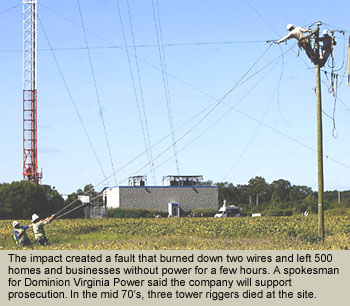 One of the BASE (building, antenna, span and earth) jumpers reportedly missed the guy wires, but struck a power line, knocking out electricity in the area, according to authorities. One of the BASE (building, antenna, span and earth) jumpers reportedly missed the guy wires, but struck a power line, knocking out electricity in the area, according to authorities.
There may have been a serious injury and police are checking local hospitals to see if the jumper was admitted. A witness said he saw people helping someone who appeared to be in pain to a Chevrolet Suburban driven by a man with long blond hair.
They fared better than William Harmon did in 1981. The Norfolk "jump-expert," climbed the WVEC-TV tower with two friends and plummeted 300 feet to his death when his parachute became tangled in a guy wire.
The WVEC-TV tower death is believed to have been the first in the extreme sport's history.
During 2005, a BASE jumper became entangled in the guy wires of a Walnut Grove, Calif. broadcast tower. His 16-minute chilling 911 call obtained by WirelessEstimator.com can be heard here.
Wednesday's jumpers had to scale a fence, cut through barbed wire and get past locked gates, said Todd Smith, the TV station's president and general manager.
In the mid 70's, three tower technicians died while working on the WVEC-TV tower. They were hoisting an antenna when one of the wires snapped.
The riggers were tied off to the tower by safety harnesses, but a cable shot back up after the tension was relieved, going back into the tower like a slingshot, according to a retired police officer who assisted in the accident.
He said that two men fell from the structure and the third worker was thrown back up into the tower bracing
|
Letter emerges putting new pressure on France Telecom to address high suicide rate
October 2, 2009 - At last week's PCIA show in Nashville, a number of the nation's largest tower companies' CEOs talked about some of the back office efficiencies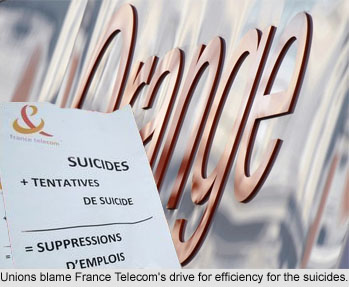 they've been able to achieve, reducing headcount while increasing productivity and income during 2008. they've been able to achieve, reducing headcount while increasing productivity and income during 2008.
Their staff reduction didn't come through suicides, but France Telecom workers say Europe's third largest telephone company's drive for efficiency in their 35-hour work week has resulted in 24 suicides in 18 months.
Last month, a 49-year-old France Telecom worker plunged a knife into his stomach during a meeting in which he had been told he was being transferred. A couple of days later a 32-year-old employee leapt to her death at a France Telecom office.
Another employee killed himself on Monday. The 51-year-old man jumped off a bridge onto a highway. In a note found in his car, the father of two blamed his act on the "atmosphere" at his workplace.
Unions blame tough management methods at the multinational, which was privatized in 1998 and has cut 40,000 jobs.
For comparison purposes, they did not provide statistics of how many suicide victims readily identify that their suicide was a result of their employer's actions, but France Telecom says their rate of suicides is statistically not unusual for a company with a 100,000 workforce.
France has a suicide rate about 50% greater than the US, and more than double that of the United Kingdom.
According to the World Health Organization, France had an annual suicide rate of 26.4 for 100,000 men in 2008. The rate for women was 9.2 suicides per 100,000.
After the latest deaths, the company has said it will add to its headcount by hiring more mental health counselors and to suspend internal job transfers pending new talks with the unions.
|
Another alarm trips up thieving trio
October 1, 2009 - Three people were behind bars Tuesday, charged with stealing copper and metal from a communications tower site in New Hanover County, N.C. copper and metal from a communications tower site in New Hanover County, N.C.
Deputies arrested Douglas Cox, Melissa Smith, and Quinton Yanick after responding to a breaking and entering alarm at Hill Valley Walk around 2:00 Tuesday morning.
Copper wire, metal blocks, and burglary tools from the tower site were found in their vehicle.
All three are in the New Hanover County Jail under a $150,000 secured bond.
Another alarmed site in Volusia County Florida resulted in the arrest (below) of a copper thief that had been targeting cell sites.
|
Nation's tower chiefs are in love with the iPhone and data usage outlook
September 29, 2009 - America’s top tower company CEOs are optimistic about the outlook for the industry for the next five to 10 years, primarily because of the nation’s insatiable desire for broadband services. insatiable desire for broadband services.
“What is going on is that we had the most important event in our history come to clarity last year which was true consumer adoption of real broadband data services,” Jim Taiclet, CEO of American Tower Corporation, said during a panel discussion at PCIA's 2009 Wireless Infrastructure Show last week.
"What that is doing for our sector is while we continue to enjoy continued growth from the voice side of the service and will for some time to come, I think we are really going to get a true second leg of growth over the next five to 10 years in the United States," Taiclet said.
"For the first time in this industry the device is driving consumer behavior, it's not the price point," Marc Ganzi, CEO of Global Tower Partners agreed. "It puts an enormous amount of pressure on networks. You have to have new sites; you have to have indoor coverage; you have to have particular small radius outdoor coverage."
"We have to as an industry address where networks are going, how they are evolving and how ultimately the device needs to be as close as possible to the antenna," Ganzi said. “We've got to think about DAS (distributed antenna systems) and smaller towers.”
W. Benjamin Moreland, Crown Castle International's CEO also equates the industry's growth curve for many years to come will be a product of America's desire to view everything on the internet on their iPhone or netbook.
"In years to come I'll look back on this year as the year that mobile turned into an entertainment device," said CEO Jeffrey Stoops of SBA Communicaitons.
"Prior to the iPhone there were Blackberries and a lot of different data users, but they never really drove the content, they never drove the bandwidth. We've now entered the mobile entertainment phase of our lives. That's pretty exciting because that's high use, big bandwidth and a lot of consumption," he said.
CEO Richard Byrne, CEO of TowerCo, and the newest member of the "View From the Top" tower company leaders, said ten years ago when he was at Nextel he observed a presentation that showed where the industry was heading over the next 25 years.
He said the chart identified that voice was going to increase at a decreasing rate and become 5% of the traffic on the network.
"It was just mind boggling at the time," Byrne said. "I think that's what we have in store for us."
Disfigured by consolidation and bankruptcies following the telecom slowdown in 2001, the industry has weathered America's failing economy and has shown that today it has a proven and robust business model, several speakers said.
"Fortunately, for all of us, we have a business model that is durable and has been tested in this recession and continues to grow," said Moreland.
Stoops concurred, stating, "Not only did the business models come through unchallenged, but they have proven out to be extremely resilient. I think all of us have hit our numbers and increased guidance. It's been a decent year."
It was noted by Stoops that Sprint is reinvesting in its network and their colocations for Q4 are increasing. It was generally agreed that one of 2009's saviors was a fully funded Clearwire building out in multiple markets.
In discussing company operating efficiencies, Ganzi said that Global Tower Partners trimmed its SG&A 15% while growing revenues by 25% and reducing employee count by 10% to 126 people.
He said that part of their success is attributed to an IT team of eight people that have developed processes to provide quicker and more efficient electronic transactions.
Both Moreland and Byrne cited back office efficiencies in cutting down operating expenses as well. Crown's current headcount to manage their 23,600 towers is 1,200, down 30 from last year. Byrne said their 3,200 towers are managed by 62 employees.
The five CEOs said acquisitions are just one part of their capital expense strategies, and each acquisition is a case-by-case buy. Neither Taiclet nor Moreland discussed opportunities in India. It has been reported that both companies have been doing due diligence on a deal for Aircel Cellular, worth between $1.6 and $2 billion.
Taiclet said that the capital expense budget for American Tower for building new towers and assets in 2010 will continue to be $200 to $250 million, but if additional financing was necessary his company could easily go to the capital markets.
Moderator and PCIA CEO Michael Fitch's question regarding the Federal Communications Commission's inquiry into whether tower owners trafficked in a competitive marketplace was summarized by Ganzi: "The participants on this stage don't control the marketplace. A lot of towers built today for carriers are in the hands of private owners and the majority of them are in the hands of carriers."
|
Alarmed site results in arrest of decked out thief
UPDATE: September 29, 2009 - The Volusia County Florida Sheriff's Office filed more burglary and grand theft charges against a man it said was connected to a second theft of copper at another cell phone tower.
David McDonald, 35, of Port Orange was already under arrest for burglary, grand theft, theft of copper, possession of burglary tools and violation of probation stemming from a cell phone tower burglary early Sunday.
A new copper theft -- from an AT&T cell phone tower on West Indian River Boulevard near Edgewater -- was reported Monday. The AT&T tower is less than a half-mile from a Verizon tower that was burglarized early Sunday, the sheriff's office said.
* * * *
September 28, 2009 - Volusia County Florida Sheriff's deputies arrested 35-year-old David McDonald of Port Orange early yesterday morning after he allegedly tried to steal copper from a Verizon cell tower site in Edgewater. copper from a Verizon cell tower site in Edgewater.
Authorities say they were responding to an alarm at the Cow Creek Rd. cell tower site when they saw McDonald riding a bicycle away from the direction of the tower.
The first thing deputies noticed was that McDonald was wearing a mask with a helmet-style flashlight on the top, was visibly perspiring and sporting fresh cuts and scrapes on his shins. The next thing they noticed was a large wrench protruding from his pocket. After securing McDonald, they also found pliers, screw drivers, wire cutters and flashlights in his pockets as well as a waist pack.
Deputies later found a duffel bag near the gate at the cell tower, and the bag was stuffed with about $500 worth of recently cut copper wire.
Donaldson was arrested for burglary, grand theft, theft of copper and possession of burglary tools.
A convicted felon, McDonald also was charged with violating his probation associated with prior convictions for grand theft and dealing in stolen property.
Deputies said they are looking into the possibility McDonald may have been involved in other cell tower copper thefts.
|
Verizon CTO warns tower owners to consider what they will charge for LTE antenna additions
September 24, 2009 - Using the opening keynote address at the the PCIA Wireless Infrastructure show in Tennessee on Tuesday as a bully pulpit, Verizon Wireless CTO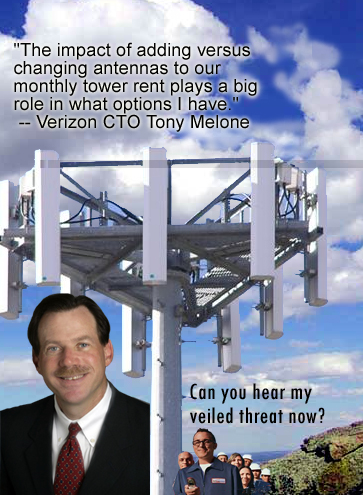 Tony Melone warned tower owners to not view 4G deployments as an opportunity to charge their current leasing fees for additional antennas that may be required. Tony Melone warned tower owners to not view 4G deployments as an opportunity to charge their current leasing fees for additional antennas that may be required.
Since Verizon will use 700 MHz spectrum for LTE, Melone said, it will require the carrier to add or change its antennas.
"The impact of adding versus changing antennas to our monthly tower rent plays a big role in what options I have," he said.
"If this part of the value chain gets out of whack, we will look for alternatives, and some of you may lose incremental revenue. So this is a great example of the importance of a well balanced ecosystem."
Verizon is a tenant on approximately 30,000 tower sites and will be looking to reduce revenues that tower owners are considering in their advisements.
"Additional and possibly larger antennas for 4G will require a number of our assets to be reinforced to handle the capacity," said one tower company executive following Melone‘s presentation.
"It’s not realistic for carriers to think that they can dictate unrealistic terms. AT&T and T-Mobile know this because they will witness the same problems with many of their towers to handle the increased loads," he said.
"In my opinion, the winners will be those that one, have sound fundamentals; two, stick to their core competencies within the value chain; and three, execute," Melone said. "The winners will also be the companies that understand this necessity of partnership and collaboration within the value chain."
Melone said that as Verizon continues to move toward its plan of launching up to 30 commercial LTE markets by the end of 2010, and matching its current 3G footprint with LTE by the end of 2013, it will also be focusing on reducing backhaul costs.
Verizon has two options for backhaul, according to Melone, Ethernet over fiber or Ethernet over microwave. "Quite frankly, I like both," he said
He said the first phase of Verizon's LTE rollout will rely mostly on fiber for backhaul. "So for those of you who like to see that play out differently, you have work to do to enhance the value proposition for the carriers."
"As with previous advancements in technology, LTE promises plenty and will likely deliver even more. Now more than ever, partnership and collaboration among participants up and down the value chain will be a major factor in the growth potential of our businesses, and our industry in general. Network reliability will be as critical as ever, and Verizon Wireless intends to be at the forefront of delivering 4G to our customers," Melone said.
|
Forecasting femtocell's future in America is proving to be unpredictable
September 22, 2009 - When femtocell units, small boxes that act like miniature cell towers, were being developed in 2005, tech-savvy writers trumpeted them as must- have equipment to obtain wireless services and programs in poor coverage areas. have equipment to obtain wireless services and programs in poor coverage areas.
Armed with no technical knowledge, residents used the femtocells at zoning and new tower siting rules hearings, stating that these units and smart antenna designs will result in tower sizes being lowered to half their height and possibly becoming obsolete.
One forum poster viewed these miniature base stations as a death threat to the tower industry, writing: "It makes sense that this would eventually happen. You're going to see cell towers a thing of the past or at least of any appreciable size. It's going to cripple tower manufacturers and put those companies that install them out of business."
There is an industry slowdown, but it's being caused by other events, with femtocells not in that mix. The units have been slow to catch on after hitting the market last year.
A number of attendees at this week's PCIA show in Nashvillle said femtocells were not a serious concern., and tower owners will remain the foundation for femtocells.
While the carriers offering them haven't made sales numbers available, ABI Research analyst Aditya Kaul estimates 100,000 femtocell units were sold world-wide last year and 790,000 units will be sold this year.
"I think there is a lot of promise, but we'll have to wait a year or two before the mass market femtocell takes off," he told the Wall Street Journal.
ABI's research report states that unit sales should reach over 9 million by 2011. However, reports from research firms and annual forecast editions from trade journals are oftentimes long on content and short on accuracy.
In 2006, another femtocell researcher at ABI predicted that by 2011 there would be 19 million units sold each year, 10 million more than the company's current forecast.
Predicting femtocell sales is no different than coaxial forecasting
However, femtocell researchers do not have exclusivity on providing questionable market predictions. market predictions.
One extensive research firm's forecast on coaxial cable showed that in 2009 the US would see an annual 18% increase in sales, reaching $1.8 billion.
"I've seen that report," said one major cable manufacturer marketing manager. I have no idea where they pulled that number from. It seems awfully high."
Support for femtocells among big wireless carriers has been uneven. AT&T Inc. doesn't sell femtocells, but is currently testing them in three cities. Verizon Wireless and Sprint Nextel Corp. offer the devices, though mostly as a stop-gap measure in areas with poor coverage.
Most femtocells cover up to 5,000 square feet and handle up to three simultaneous calls. While each device is typically tied to one account, the owner can grant access to other cellphones as long as they use the same carrier.
Kevin Packingham, senior vice president of product development for Sprint, calls femtocells a retention tool. Sprint's device, called the Airave, costs $100 plus a $5 monthly fee on top of the regular monthly bill.
Packingham told the Wall Street Journal that advertising would ramp up with next-generation femtocells since it will be easier to promote the additional data services that can run off of the device, rather than the coverage benefits.
"Looking down the road, in several years, I think everyone will have one," he said.
Verizon Wireless began offering its first femtocell, which it refers to as a Network Extender, earlier this year. A spokesman says the Samsung device, which costs $250, is "finding its audience."
Easing capacity strain on local towers is the primary perk for carriers of a femtocell. In addition, it provides the opportunity to develop a new profit center that is available because they have poor service areas.
The name femtocell was adopted by the industry because it infers that the unit is a small cell site. In the scientific community, "femto" represents one millionth of a billionth - a level of accuracy seldom found in research reports.
Next tower killer said to be ad hoc networks
A new programming language developed by researchers at the University of Cambridge in England, using peer-to-peer mobile device networks, called "pocket-switched networks," could allow communications between wireless devices without the need for conventional cellular networks, thereby eliminating the need for cell towers and base stations, researchers said in a recent issue of MIT's Technology Review.
For example, with an ad hoc network, if a hurricane knocked down cell towers, as happened when Hurricane Katrina hit near New Orleans in 2005, people using wireless devices could theoretically contact one another over pocket-switched networks.
Ad hoc networks would also make it possible for, say, a tourist visiting a city to get information about hotels and restaurants directly from local residents or businesses, instead of having to log onto the Internet for such information.
It's doubtful that femtocells and ad hoc networks will cripple the industry, and it is expected that the CEOs of the major tower companies will issue a rosy report on Wednesday during their View From The Top session at PCIA.
A stock hawking TV celebrity agrees.
"If I had to start over again, I would be in the tower business," said Jim Cramer on CNBC's "Stop Trading!" on Monday. "It's just a remarkable business."
He said that the only way to deal with such problems as frequent dropped calls on cell phones is to build more cell phone towers. "We need more infrastructure," he said.
In addition, with the rollout of LTE networks and 4G deployments, tower owners and rooftop management companies are going to see larger antennas being installed.
|
Sabotaging towers works its way north
September 16, 2009 - Purposely toppled communications towers in the US during the past two weeks has reached three, two of them in Snohomish, Wash. (see below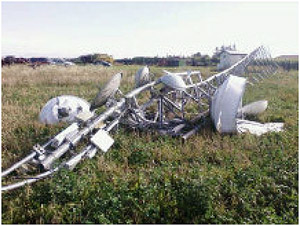 update), where the Earth Liberation Front is taking credit, and in Whitehall Township, Pa., where a 350-foot-tall tower crashed to the ground after being vandalized on the same morning. update), where the Earth Liberation Front is taking credit, and in Whitehall Township, Pa., where a 350-foot-tall tower crashed to the ground after being vandalized on the same morning.
Neighboring Canada also had a sabotage this past weekend when a 120-foot self supporting tower was felled in southwestern Ontario after someone cut through the base of the structure. The collapse knocked out internet service to more than 7,000 people in Wellington County.
“To think somebody would actually do something like this – you just shake your head,” said Richard Cantin, president of Everus Communications, the Waterloo- Holstein based company that owns the tower.
“It took planning, it was deliberate,” Cantin said. He doubts the vandalism was a prank.
“There’s a lot of things it could be,” he said. “We’re just trying to narrow that down to try and figure out who did it.”
Wellington OPP Constable Mark Cloes said it’s clear the vandalism was a “deliberate act.
“It could be a competitor or someone who had a grudge or someone who doesn’t like towers,” Cloes said. “You just never know.”
Damage to the tower is estimated at $100,000.
|
It's a concern for the tower industry
OSHA says it's funded to step up enforcement
of multi-employer worksite policy
September 15, 2009 - OSHA's interim administrator, Jordan Barab, isn't shy about emphasizing that under President Obama's administration, OSHA will be stepping  up enforcement. up enforcement.
During a recent speech, he pointed out that OSHA plans to use part of their increased funding to hire 130 more inspectors, 25 more investigators assigned specifically to whistleblower cases and 20 more workers who will help develop safety and health standards.
“I want to be absolutely clear, OSHA is back in the business of standards and enforcement,” said Barab.Barab's pronouncement came on the heels of the Eighth Circuit restoring to OSHA one of the agency’s strongest enforcement tools in the construction industry, the multi-employer worksite policy.
Where employees of various employers often work in close proximity, such as at a communications tower site, OSHA historically followed a multi-employer worksite policy.
Under that directive, safety and health citations could be issued not only to employers exposing their own employees to safety hazards, but also to employers that created the hazard, employers responsible for correcting the hazard and employers exercising general supervisory authority over the construction worksite.
OSHA’s use of the multi-employer worksite policy was significantly limited, however, by the Occupational Safety and Health Review Commission’s 2007 decision in Secretary of Labor v. Summit Contractors, Inc.
In that administrative decision, the OSHRC held that a controlling employer cannot be cited for a construction-industry-standard violation based on a hazard that it did not create and to which it did not expose its own employees.
Although many general contractors and subcontractors in the communications industry, who also subcontract their work, said they would still ensure that safety on the jobsite would continue to be a communal concern, they privately saw the decision as a welcomed relief of not having to be aligned to their subcontractor's performance.
Decision says tower contractors are no longer off the hook
Earlier this year, however, the U.S. Court of Appeals for the Eighth Circuit reversed the OSHRC’s decision in Summit Contractors. Although the Eighth Circuit’s decision does not have legal effect outside the geographic boundaries of that court’s jurisdiction (Ark., Iowa, Minn., Mo., Nebr., N.D. and S.D.), it is likely to have the practical effect of increasing the number of OSHA citations issued throughout the country.
OSHA, encouraged by the Eighth Circuit’s decision and Barab's quest for greater enforcement, might signal agency investigators to issue citations nationwide to general contractors for subcontractors’ violations in the expectation that appellate courts in other circuits would agree that the broad, traditional approach to “controlling employer” liability is the correct one.
Until litigation over the multi-employer worksite policy is resolved with finality by the Supreme Court, general contractors in the tower industry should guard against “controlling employer” liability in every state in order to avoid OSHA citations and the costly litigation they bring.
It should also raise alarms to every subcontractor in every discipline of a communications project, including 1099 contractors on a job site.
NATE web cast to address liability issues
Troubled about how the reintroduction of the multi-employer worksite policy will affect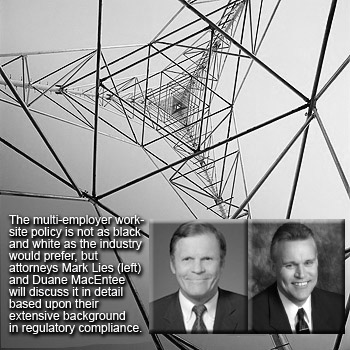 liability in the tower industry under a new administration, the National Association of Tower Erectors will be presenting a web cast on Wednesday, September 16 at 11:00 a.m. (CT) to address those issues. liability in the tower industry under a new administration, the National Association of Tower Erectors will be presenting a web cast on Wednesday, September 16 at 11:00 a.m. (CT) to address those issues.
To register and listen to the event, click here.
The live web cast to tower owners, contractors, operators and industry enthusiasts is being sponsored by Stainless LLC, and will be led by Mark Lies, NATE’s legal counsel and partner at Seyfarth Shaw LLP, and Duane MacEntee, president and chief operating officer of Stainless LLC.
There will be a Q&A session following NATE's presentation. Answers to audience questions will be posted on the association's web site.
"In today's regulatory environment, it is more critical than ever that companies and managers are aware of their civil and criminal liability. This webinar will identify these liabilities and provide meaningful advice on how to address them," said Lies.
Please see: Vertical Realtor could be fined due to Pole Painter's actions
|
Services set for technician who fell in Missouri
UPDATE: September 15, 2009 - Family and friends' visitation hours for Justin Lee Stamps will be from 9:00 a.m to 7:00 p.m. on Thursday and Friday, September 17 and 18 at the Hersman-Nichols Funeral Home, 111 N.E. 2nd St., Wagoner, Okla.
Funeral services will be at 10:00 a.m., Saturday, September 19 in the Assembly of God Church with the Reverend Terry Presley and Steve Lay officiating. Interment will follow in Pioneer Cemetery. For further information call the funeral home at 918-485-2213.
* * * * * * * *
September 14, 2009 - An Okla. tower technician died this morning when he reportedly fell from the top of a 325-foot guyed tower in Oregon County, Mo. as he was transitioning without being tied off.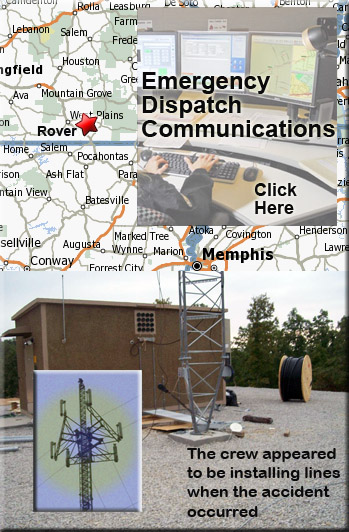
Oregon County Deputy Coroner Robert Clary said that Justin Stamps, 26, of Wagoner fell from the structure and died immediately from blunt force trauma.
Stamps was employed by S&S Communication Specialists Inc. The Hurlbert, Okla. tower erector recently completed installation of the U.S. Cellular structure located about two miles west of the junction of US Hwy. 160 and Hwy. 99 at Thomasville.
The Rover Volunteer Fire Department provided an immediate response to the tower site, and was preparing for a helicopter lift (audio), but Clary pronounced Stamps dead at the scene at 9:06 a.m.
Reports indicate that the experienced rigger was not attached to a safe anchorage point when he fell. OSHA is investigating.
S&S Communications is owned by brothers Kenneth and Randall Shankle who have 55 years of experience between them. The company is one of U.S. Cellular's primary contractors.
Kenneth Shankle said that Stamps had been with his company for less than a year, but had experience with a number of companies prior to his employment. He said that until such time that OSHA has completed their investigation he would not want to speculate as to how the accident occurred.
Stamps is the fourth fatality this year of a tower technician falling from an elevated structure.
Stamps was “moving up” on the tower when he fell more than 300 feet to his death, his mother, Tina Stamps.
“They were finished where they were working and getting ready to move up the tower,” Stamps said she was told by an S&S Communications Specialist official. “He went to hook up, and he missed.”
Besides his job, Stamps loved bull riding and anything western, but most of all he loved people, his friends and family said.
That love of people was evidenced today as dozens of cars and pickups lined the long driveway to the home of his parents, Randy and Tina Stamps. Another dozen cars that couldn’t get into the driveway lined the county road in front of the house, according to the Muscogee Phoenix.
Funeral services for Stamps are being planned with Hersman-Nichols Funeral Home of Wagoner.
Justin is survived by his parents, Randy and Tina Stamps of Wagoner and Alan Cook of Porter; his sisters, Amber Stamps of Wagoner and Christy Warren and husband Robert of Muskogee; his brothers, Ronnie Stamps and wife Jessica and Chouteau and Teddy Cook of Porter; grandparents, Grady and Jane Lawhorn of Wagoner and Tommy Stamps of Pryor.
|
Broadcast engineers return to Mt. Wilson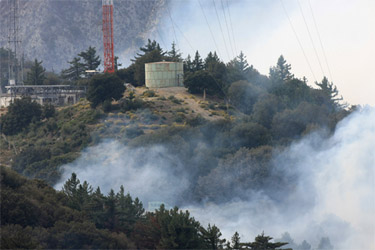
September 14, 2009 - The on again-off again nail-biting fire watch at Mt. Wilson in Calif. appears to be finally off and engineers are returning to the tower complex today to find their facilities in excellent shape except for air filters clogged with soot even though most buildings were using recirculated air.
The area still has some smoke from backfires that were set such as seen in this September 11, 2009 photo.
Firefighters are being held in the highest regard for their efforts in saving the telecommunications complex and the nearby Mt. Wilson Observatory. See article below.
|
Broadcast tower revives haunting memories of 9/11
September 11, 2009 - One of the most popular attractions in Washington today will be the mangled and twisted tower that once broadcast radio and television signals to the New York metro area from top of the World Trade Center.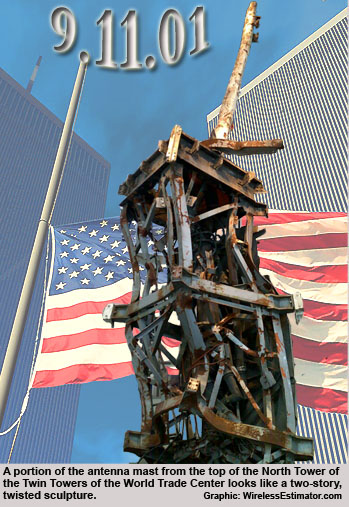
The structure is part of a permanent 9/11 exhibit at the Newseum, the capital's tribute to press freedom and the other protections of the First Amendment.
The mast is probably the last part of the building most people saw when it collapsed.
The fourth-floor 9/11 Gallery provides a haunting moment with its centerpiece: the top 35 feet of the 360-foot antenna mast that once crowned the North Tower and formed Manhattan’s highest point. The gnarled coil of charred metal is a visceral representation of the damage done.
The gallery also includes 127 front pages published on September 12, 2001 by newspapers around the world.
The Trade Center tower is just one striking artifact inside the high-tech journalism museum, which also includes large sections of the Berlin Wall, archival video and newspapers dating back nearly 500 years, and thousands of other objects to wow news junkies.
The September 11 tragedy was particularly sorrowful for many employees of American Tower Corporation of Boston. The company announced the following day that 13 employees of a subsidiary perished after the planes struck the twin towers. See: Day of Remembrance.
|
Five die as guy wire slices into small aircraft
September 8 , 2009 - A small plane on its way to Dallas for the University of Oklahoma football game crashed into Chandler Park in Tulsa, Okla. amid foggy conditions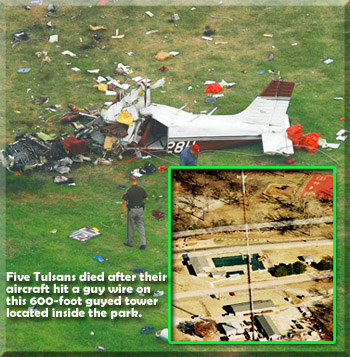 Saturday morning, killing all five Tulsans aboard. Saturday morning, killing all five Tulsans aboard.
Dr. Stephen Lester, his wife, Dana, their daughters 16-year-old Laura and 13-year-old Christina, and another doctor, Ken Veteto, all died at the scene, family members said.
Their plane, a six-passenger Piper, left Jones Riverside Airport at 10:37 a.m. and crashed within minutes after it hit a guy wire of a tower in the park, said Lt. George Brown of the Oklahoma Highway Patrol.
Witnesses said the conditions were extremely foggy, and the tower wasn't visible from a distance, although it had obstruction lighting. Stephen Lester, the owner of the plane, was piloting, according to the OHP.
The Lesters' plane came down southwest of a baseball field in Chandler Park, leaving the ground charred as it skidded. When the plane hit, its wings came off and its body flipped end-over-end several times.
Two passengers were ejected between 500 and 600 feet upon impact, the Highway Patrol reported.
Global Tower Partners LLC of Boca Raton, Fld. purchased the 600-foot guyed tower from Titan Towers LP of Abilene, Tex. in 2004. The tower did not collapse, but is being checked for structural damage that might have occurred. |
Eco-terrorist group says it was responsible for two-tower takedown in Washington
UPDATE: September 16, 2009 - KRKO's president Andy Skotdal is pinning the Sept. 4 toppling of his two AM radio towers on local opponents, not the eco-terrorists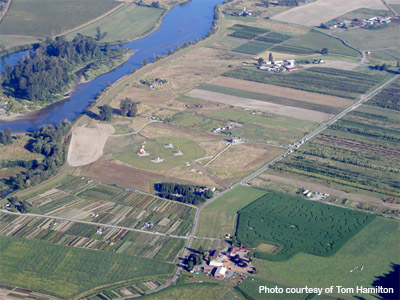 that are taking credit for it. that are taking credit for it.
The Citizens to Preserve the Upper Snohomish River Valley, who fought the project for nine years, reject the accusation and resent the implication.
“I think (Skotdal’s) just blowing smoke — I certainly hope it’s not true,” CPUSRV president Lee Bennett said to the Snohomis County Tribune. “I’m not aware of anybody who would do it.”
Skotdal denied a rumor that he named names to the FBI, which is leading the investigation. Bennett had FBI agents at his door on Sept. 10, but he perceived it was normal investigation business. Bennett said he thinks the FBI is looking for local suspects.
It is not known whether the tower complex has surveillance cameras.
Skotdal's radio station is offering a $25,000 reward for information that leads to the arrest and conviction of whomever is responsible.
UPDATE: September 8, 2009 - Based upon an eyewitness to the tower collapses on Friday, FBI agents have searched the banks of the Snohomish River to aid them in the capture of the individuals that sabotaged the KRKO towers.
A neighbor who did not want to be identified told KOMO News that he was awakened at 3 a.m. by the noise of machinery a couple of hundred yards away from his house.
He said he got up and left his house in time to see one of the two towers fall. He then grabbed a shotgun and charged across the field, chasing a man he says he saw getting out of the trackhoe used to knock down the towers.
Earlier reports had three people involved in the toppling of the two AM towers.
The neighbor told KOMO News that he was gaining on the man when he suddenly ducked into some bushes alongside the Snohomish River.
At that point, the neighbor says he decided to give up the chase rather than take the chance of also going into the bushes.
David Gomez, the assistant FBI agent in charge of the Seattle bureau, said agents searched the riverbank looking for footprints or any other trace evidence.
Two men were seen driving away from a fishing beach just upriver from the toppled towers. The FBI is talking to fishermen who believe that the two men they saw may have used a boat to get to the fishing beach, and then drove off at a time when most anglers would be arriving for an early morning catch.
Protester compares it to the Boston Tea Party of towers
Some neighbors said they were not sorry to see the towers down.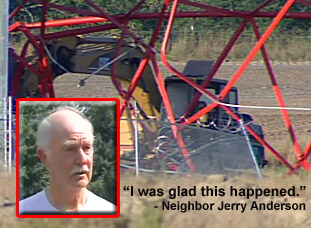
Jerry and Doris Anderson, who were among those who protested the antennas, and live a half mile away, said they both woke up at about 3 a.m. by unusual noises.
They told KOMO News that they heard about 12 minutes of pounding before the tower fell.
Doris said she did not advocate destruction of private property as a way of fighting the towers.
However, Jerry fully agreed with the destruction.
"I was glad that this happened. It just made me think of the Boston Tea Party...that there is still some American bravado going on."
"We went through an extensive permitting process to get this project going, and there was some opposition in the valley that we had to deal with," said KRKO General Manager Andy Skotdal. "The testimony at the hearings was often very bitter and negative."
Skotdal says that it might not be members of ELF who felled the towers, but opponents of the structures that are now acting in desperation.
NATE Chairman finds acts to be cowardly
"These cowardly acts of vandalism in Washington and Pennsylvania are unfortunate, and serve only to set back the businesses that so many people have come to rely on for their local communications needs. We hope that the stations affected are able to rebuild the fallen towers shortly," said Jim Coleman, Chairman of the National Association of Tower Erectors.
The National Association of Broadcasters and PCIA - The Wireless Infrastructure Association, are weighing whether they will issue a formal statement regarding their grave concerns about the felling of the two towers and the Earth Liberation Front's call for additional action by activists.
|
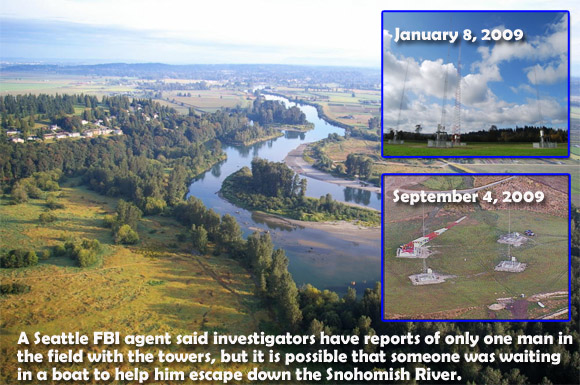 |
UPDATE: September 5, 2009 - The FBI is investigating a Pennsylvania radio tower collapse to see if there is a possible link to the two Everett, Washington towers that were sabotaged early yesterday morning.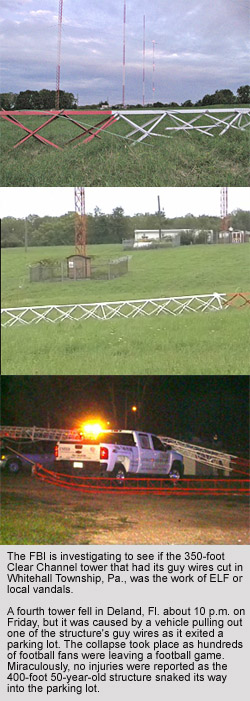
The Whitehall Township 350-foot-tall tower crashed to the ground at approximately 1:00 a.m. The WAEB tower, one of a five-tower-array owned by Clear Channel just west of MacArthur Road, lay splayed across an open field.
Five hours later, two radio towers near Everett, Wash., were knocked to the ground by a trackhoe in what the FBI fears was an act of eco-terrorism. The Earth Liberation Front said it was the work of their covert terrorists and urged them to "continue to take direct action to stop the threats to human health, wildlife and the planet."
'The FBI is aware of the Whitehall case and is going to be looking into it, said J.J. Klaver, FBI special agent in Philadelphia. 'I don't want to venture a guess as to whether the two things are related. That's probably premature.'
Klaver added, however, that it is extraordinary that one radio tower would be toppled in the East and two would fall in the West on the same morning.
'It looks like some of the cables were cut,' a township police spokesman said. 'It appears to be criminal mischief. The Detective Division has the case.'
ELF took credit for the felling of the two Washington towers on their web site, but did not mention the Whitehall Township incident.
A fourth tower fell in Deland, Florida about 10 p.m. on Friday, but it was caused by a vehicle pulling out one of the structure's guy wires as it exited a parking lot. Witnesses said a red Jeep had snagged one of the tower's guy wires on its rear bumper.
The collapse took place as hundreds of football fans were leaving a football game.
A number of vehicles with passengers were damaged, but miraculously, no injuries were reported as the 400-foot 50-year-old structure snaked its way into the crowded parking lot.
* * * * * * * * * * * * * *
September 4, 2009 - Two controversial broadcast towers were toppled early this morning by terrorists using a stolen trackhoe in Snohomish, Wash.
The recently installed structures, belonging to Everett radio station KRKO, were reportedly felled by the Earth Liberation Front. A banner was placed on a compound fence stating, "Wassup? Sno. City? ELF".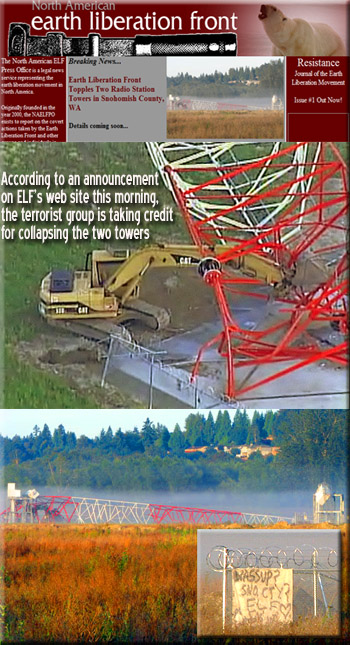
In addition, on the North American ELF website, the group claims responsibility for the sabotage.
"Due to the health and environmental risks associated with radio waves emitted from the towers, we applaud this act by the ELF," stated Jason Crawford, a spokesperson for the North American Earth Liberation Front Press Office.
"When all legal channels of opposition have been exhausted, concerned citizens have to take action into their own hands to protect life and the planet."
"We have to weigh our priorities and the local ecosystem in Everett, along with the local residents, do not need additional sports news radio station towers that come at the expense of reduced property values and harmful radio waves," Crawford continued. "We sincerely hope that people continue to take direct action to stop the threats to human health, wildlife and the planet."
The FBI has taken over the investigation and describes ELF as an eco-terrorist group.
Andrew Skotdal, president and manager of his family owned sports radio station, said he doubted that ELF was responsible for the sabotage and the sign may have been planted to throw authorities off track.
However, the FBI is investigating the strong possibility that it was done by ELF, as they claim, since they do have a history of operating in Snohomish County. They are blamed for the multimillion-dollar fire that destroyed the Street of Dreams development last March near Echo Lake.
ELF, known for violent acts in the name of environmentalism, also left a sign at the scene and was suspected to have set fire to the swanky, newly built neighborhood.
A $100,000 reward was offered by the Building Industry Association of Washington for information leading to the arrest and conviction of those responsible for the $7 million in damages by the fire.
No arrests have been made and the FBI is still investigating.
KRKO is providing a $25,000 reward to find the persons responsible for this morning's destruction.
Skotdal said several people were very upset about the project, but he did not know if those people were involved in the sabotage. The bottom line of ELF's banner is difficult to view from news station helicopter shots, but appears to read: "PS. Skotdals Abandon this or...".
ELF uses economic sabotage and guerrilla warfare to stop what it calls the exploitation and destruction of the environment.
Two trade organizations, the National Association of Broadcasters and PCIA - The Wireless Infrastructure Association, are weighing whether they will issue a formal statement regarding their grave concerns about the felling of the two towers and Crawford's call for additional action by activists.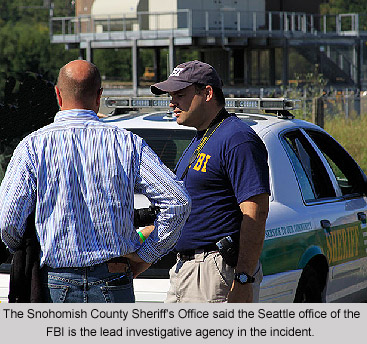
A call to ELF's press office for comment this morning wasn't returned.
A neighbor called 911 around 3:30 a.m. to report that someone appeared to be using a bulldozer to knock the radio towers over, police officials said. The towers are in the 13400 block of Short School Road in unincorporated Snohomish.
Deputies arrived to find a 349-foot tower and a smaller one toppled and heavy construction equipment at the scene.
Additional calls were received from citizens who said they saw three people running from the scene. A search by police and a police dog was unsuccessful.
The trackhoe ripped through one face's cross bracing on the self supporting tower, causing the base section to buckle and force the tower to lay straight down across an open field.
Police said the vandals stole the trackhoe from a fenced yard, broke through a fence surrounding the towers and then used the machinery to pull both towers down.
The station has been in a 10-year battle with opponents of an addition to its existing towers east of Everett.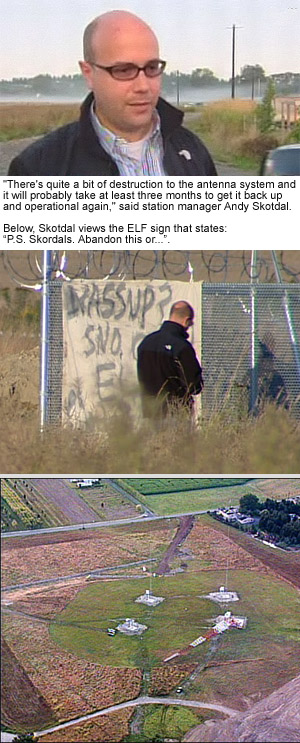
Last month, a King County Superior Court judge upheld a February land-use decision by the Snohomish County Council approving two 199-foot AM structures to be constructed next to three existing towers that occupy the site.
Opponents of the towers filed a court appeal in March, claiming the council did not follow proper procedure when it decided in to let S-R Broadcasting build the towers.
The council had overturned a hearing examiner's decision to deny a permit for the towers, based on claims that radio signals are dangerous to human health. They said the hearing examiner's decision was based on questionable scientific evidence.
Tower opponents cited a range of studies claiming that AM radio waves have negative effects on people and wildlife -- among them, increased rates of childhood leukemia and destruction of trumpeter swan habitat.
The new towers were part of a plan to expand the station’s signal. Since February, KRKO was using a new transmitter and had increased its power from 5 kW to 34 kW during the day and 50 kW at night.
KRKO is using a backup transmitter to remain on the air.
An official damage estimate wasn't available, but Skotdal figures it will cost "a couple million dollars" to replace the towers.
"I don't look at this like it's some devastating thing. I look at it as something we can fix," he said. "So much has gone on in the last nine years that this is just another event that doesn't faze me," he said.
The investigation is being headed by the Seattle field office of the FBI because the incident is possibly an act of domestic terrorism, said Special Agent Marty Prewett.
The Skotdal family plans to expand its operations after beating out 12 other applicants for its second permit from the Federal Communications Commission to transmit on 1520 AM.
The family plans to build its second, 50,000-watt station on the tower site by next summer, Skotdal said.
|
New Jersey tech arrested for Florida copper theft
September 2, 2009 - A New Jersey tower technician was arrested by the Bradford County Florida Sheriff's Office Monday evening after returning to Florida to begin a new project. new project.
Officials described Thomas Britton, 34, as an industry insider who was allegedly involved in recent burglaries at cell phone towers.
Authorities say Britton was charged with theft from a communications provider and criminal mischief.
Sheriff's Detective Johnny Pons worked with confidential informants to find and arrest Britton at a Lawtey convenience store Monday after Britton returned to the area from New Jersey.
According to Sheriff's Captain Brad Smith, Britton apparently worked as a subcontractor at several cell phone tower sites and knew which items were worth stealing to resell.
Investigators said the motive for the thefts appeared to be financial and two other men arrested were friends. The case began when deputies got a tip that some of the materials believed to have been taken from the tower were being transported to an area scrap dealer.
The first person arrested in early August was identified as James Michael Harper, 27, of Starke. He was charged with grand theft, burglary, burglary that impaired a utility, dealing in stolen property and criminal mischief involving a utility.
John J. Thornton, 28, of Starke, was later arrested, according to the Gainesville Sun, and was charged with grand theft, larceny and criminal mischief. Smith said Thornton likely served as the driver in the burglary.
|
Tower complex appears to have been spared as
Mt. Wilson Station Fire becomes more controllable
UPDATE: September 2, 2009 - Broadcasters are not reporting any operational problems caused by the Station Fire at Mt. Wilson, and are still being served by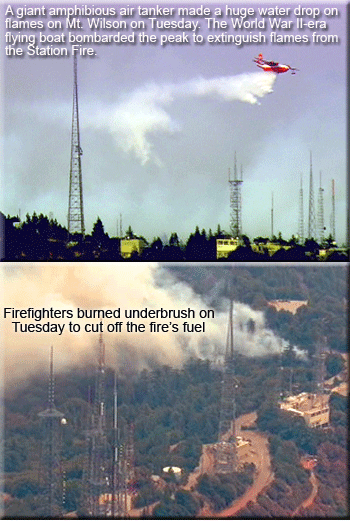 commercial power. commercial power.
Additional backfires were set yesterday which fire officials said helped to keep the wildfire from reaching the tower complex. Also, water drops from an amphibious air tanker assisted in controlling the raging fire.
Although on Tuesday afternoon it appeared that the area might be engulfed in flames as plumes of smoke covered the nearby observatory, firefighters said the billowing clouds were caused by the backfires.
Drip torches were used most of yesterday to clear ground debris around the antenna farm that would fuel an approaching fire.
A popular webcam from the century-old Mt. Wilson Observatory was put out of commission yesterday afternoon when its telco line was reportedly damaged by the backfire.
More than 150 firefighters were up on Mt. Wilson this morning along with eight engines equipped to spray fire retardant on structures in addition to the crew engines, according to LA County Deputy Fire Chief Jim Powers.
Five structures at risk owned by American Tower
As each briefing becomes more enthusiastic, American Tower Corporation's managers are able to breathe a little easier. The Boston-based tower company owns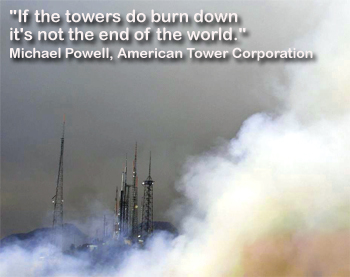 five of the complex's 29 structures. The company also has two others on nearby Mount Harvard, an area also under threat. five of the complex's 29 structures. The company also has two others on nearby Mount Harvard, an area also under threat.
“Our primary concern is for the safety of the people. If the towers do burn down it’s not the end of the world,” Michael Powell, director of investor relations said yesterday in an interview with Bloomberg News.
“We’re working with our customers to provide them service from other towers in the surrounding areas so their signals don’t go out,” Powell said.
An ATC manager was able to view the firm's assetts this afternoon and his initial assessment indicated that there was no noticeable damage to the buildings or towers.
Similar to what it's done during other natural disasters, the FCC's Media Bureau has relaxed several rule formalities to help stations remain on the air in case the fire reaches the peak. Stations have ten days instead of 24 hours to alert the FCC they're using an emergency antenna. AMs can also operate at full daytime power through the night to broadcast emergency information as long as they drop all commercials.
UPDATE: August 31,2009 (11:00 A.M PST) - Inspector Edward Osorio of the Los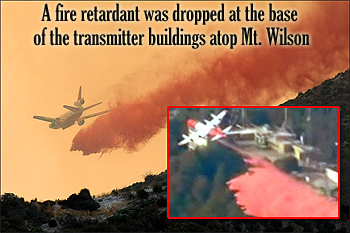 Angeles County Fire Department said the fire is expected to move in a northeasterly direction, and officials are putting significant resources on the northern edge of the fire near Acton. Angeles County Fire Department said the fire is expected to move in a northeasterly direction, and officials are putting significant resources on the northern edge of the fire near Acton.
Mt. Wilson was believed doomed last night, but Osorio said aggressive brush clearance by crews and drops of fire retardant from the air seem to have helped.
"At this point, I don't think it suffered any serious damage. We'll probably get some flare-ups or threatening flame activity, but we don't think it's going to be a major problem," he said.
According to John Holland, director of engineering at KABC-TV, it's possible the TV station could stay on the air even if the fire burns through the complex. The station's tower is structurally adequate, he says, and the transmitter at its base is housed in a concrete building. The generator that kicks in if power is cut has several days' worth of fuel, said Holland.
A number of station engineers said that they are still under commercial power and they are not experiencing any outages from Southern California Edison.
If the fire rages through the compound, however, it is likely that the hundreds of runs of coaxial cable would ignite and cause severe damage to the supporting structures.
Even before the fire arrives at the tower, heat transfer from the wildfire front can precede the flames, warming the air to 1,470 °F and pre-heating the transmission line's jacket and polyethylene insulation. An ignition point for polyethylene could occur above 650 °F.
Although TV stations might still be able to broadcast because of the rigid plumbing used for their antennas, the loss of their coaxial lines would severely hamper helicopter reports and other news functions.
* * * * * * * * * * * * *
August 31, 2009 - The California wildfire that has expanded to at least 35,200 acres, leaped over the San Gabriel Mountains Sunday, and is prompting more evacuations.
Firefighters had been pulled away from Mt. Wilson, where almost two dozen critical 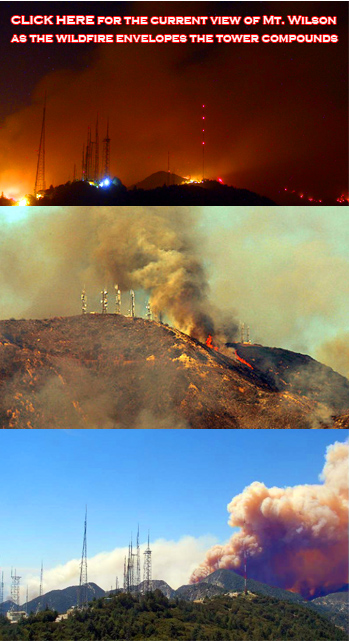 broadcast towers for many television and radio stations are located. Fire officials said the mountain had been overrun with fire by 7:00 p.m. Sunday, but it is not known if it has caused outage for local broadcast news outlets. broadcast towers for many television and radio stations are located. Fire officials said the mountain had been overrun with fire by 7:00 p.m. Sunday, but it is not known if it has caused outage for local broadcast news outlets.
Electrical service might still be available on Mt. Wilson since obstruction lighting was visible early this morning from a Mt. Wilson webcam (Intermittent Coverage).
However, it could be that generators have taken over, explained Larry Lopez, whose firm performs maintenance for a number of Mt. Wilson broadcasters.
"We won't know what damage has occurred until authorities let us up there," he said.
U.S. Forest Service authorities closed Mt. Wilson Road about 6 a.m. today.
Although current webcam pictures show a large area around the site that appears to have been saved, the wildfire was moving from the back side of the camera's view.
Yesterday, crews cleared brush and sprayed retardant in an attempt to ward off flames approaching the transmitters of more than 20 television stations, many radio stations and cell phone providers, said U.S. Forest Service Capt. Mike Dietrich.
Television stations said if the antennas burn broadcast signals would be affected but satellite and cable transmissions would not be.
Two giant telescopes and several multimillion-dollar university programs are housed in the century-old Mt. Wilson Observatory. The complex of buildings is both a historic landmark and a thriving modern center for astronomy.
The fire has been growing steadily, doubling in size on Sunday. Dietrich said it was possible it would double in size yet again over the next few days.
In addition to threatening the TV and radio stations' broadcast facilities, the wildfire could knock out cell phone service and some emergency law enforcement communications.
Los Angeles police and fire departments do not use the tower, and neither does the Los Angeles County Sheriff's Department.
"There's a lot of dollar value in those towers and of course, what they mean to broadcasters in Southern California," Harold McAlister, director of the nonprofit Mt. Wilson Institute, told the Los Angeles Times. "Mt. Wilson Observatory is actually a 40-acre tract of land with 50 to 60 buildings on it."
Dozens of technicians are normally stationed at Mt. Wilson to keep the broadcast stations and vital police and fire radio dispatch equipment functioning, but were evacuated before the weekend.
The fire's intense heat has the capability of weakening the towers. Road signs have already melted and guardrails had burned free of their wood moorings.
The weather is predicted to be around 98 degrees today, and the National Weather Service warned that gusty winds could kick up in the afternoon which would exacerbate existing dangerous fire weather conditions.
The tallest tower on Mt. Wilson, according to FCC database, is the guyed mast of CBS at a height of 972 feet built in 1986. The antenna farm, at an altitude of 5,715 feet, has seen a great deal of activity in the past year as TV broadcasters changed out their analog antennas.
Clear Channel, Citadel, Bonneville, CBS Radio, Salem, and Mt. Wilson FM Broadcasters are among the broadcasters using towers at the Mt. Wilson facility, along with every major TV station in Los Angeles.
A number of them are owned by tower consolidators such as American Tower Corporation.
Should the Mt. Wilson TV facilities be consumed, the situation would be similar to what TV stations in New York City dealt with after 9/11, one veteran broadcast engineer said.
TV stations there transmitted from the top of the World Trade Centers, and had to scramble to move back to the Empire State Building, where CBS had retained antenna leases.
There are no comparable alternative transmitter sites in the Los Angeles market.
A partial list of Mt. Wilson broadcasters includes:
FM STATIONS
KPFK(FM) 90.7 mhz (110,000 watts)
KBIG(FM) 104.3 mhz (105,000 watts)
KLOS(FM) 95.5 mhz (63,000 watts)
KTWV(FM) 94.7 mhz (58,000 watts)
KRTH(FM) 101.1 mhz (51,000 watts)
KCMG(FM) 92.3 mhz (43,000 watts)
KLVE(FM) 107.5 mhz (29,500 watts)
KCBS(FM) 93.1 mhz (28,500 watts)
KPWR(FM) 105.9 mhz (25,000 watts)
KLSX(FM) 97.1 mhz (20,900 watts)
KZLA(FM) 93.9 mhz (18,700 watts)
KMZT(FM) 105.1 mhz (17,600 watts)
KPCC(FM) 89.3 FM (600 watts)
TELEVISION STATIONS
KCOP(TV) Ch. 13 (162,000 watts)
KTTV(TV) Ch. 11 (166,000 watts)
KCAL(TV) Ch. 9 (141,000 watts)
KABC(TV) Ch. 7 (159,000 watts)
KTLA(TV) Ch. 5 (44,700 watts)
KNBC(TV) Ch. 4 (44,700 watts)
KCBS(TV): Ch. 2 (36,300 watts)
|
Tower tech gets 90 days in jail; insurance company might have to pony up $5 million
August 26, 2009 - A tower tech, who pleaded guilty to an arson charge after accidentally touching off a wildfire on Santa Catalina Island in Calif. in 2007, was sentenced in Long Beach Superior Court yesterday to serve 90 days in jail.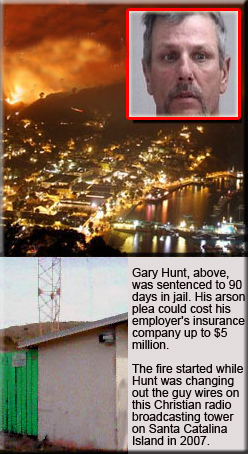
Gary Dennis Hunt, 51, will serve the time in the L.A. County Men's Central Jail or in a similar facility in his home state of Indiana, and five years of formal probation. He could also opt to serve more than 100 hours of community service, provided it meets with court approval.
He had previously faced multiple counts that carried a jail sentence of up to eight years in state prison than the single count Hunt pleaded to earlier this year.
Hunt, who started the blaze with an open-flame torch while cutting a guy wire on KBRT-AM 740's tower, was also ordered to pay more than $4 million in restitution to victims of the fire.
However, the amount could climb to more than $5 million following Southern California Edison's calculated loss once it is received by the court.
The court ordered Hunt pay $85,000 in restitution to the Wilson family that lost their home in the blaze. He was ordered to pay $2,886,536.82 to the Santa Catalina Island Co. and $1,152,377 to the Santa Catalina Island Conservancy.
At the time of the incident when the guy wires were being changed out, the area had clearly posted warnings of extreme fire danger and that open flames were not permitted.
On the first day of work, sparks from the torch fell onto nearby brush and caused several small fires that Hunt put out, defense attorney Michael Zimbert said.
Hunt returned the following day and under the same hot, dry and windy conditions, used the torch again, and started a blaze that quickly spread out of control, Zimbert said.
Zimbert said the restitution and fines will be paid by the insurance covering the company for which Hunt was contracted to work.
"What's ongoing is how much restitution it's going to be," Zimbert said, noting that a civil lawsuit is also pending.
Hunt was working as a 1099 independent contractor for Allstate Tower, Inc. of Henderson, KY, according to a spokesperson from the Los Angeles County District Attorney's Office.
Allstate's insurer is also being taxed by a recent claim in Alabama. The company was dismantling a water tower on July 21 when the structure fell and falling steel landed on top of a nearby dry cleaners as well as onto a power line. One minor injury was reported.
Hunt pleaded no contest to the felony arson charge that touched off the brush fire on Catalina Island in May of 2007 and caused an estimated $20 million in damage to several structures, including one family's home, and 4,000 acres of land.
Bill Agresta, chief engineer at the Christian radio broadcasting station, said that tower workers had been cutting the guy wire tails with a gas-powered circular saw when the fire ignited. It was later stated by the L.A. District Attorney's Office that Hunt had been using a torch.
Agresta said he saw a small blaze and ran inside the station to call 911. By the time he returned, it had moved several hundred feet downhill and engulfed the tower crew's tool truck.
Victims of the fire can still sue Hunt in civil court.
In addition to restitution, Hunt was ordered to pay more than $2,000 in victim's fund and court fines. He must register as a convicted arsonist, and will have to submit DNA and fingerprint samples.
|
Canadian worker survives equipment failure fall
August 20 - 2009 - A 40-year-old man working on a communications tower fell approximately 25 feet yesterday in Ottawa, Can., and suffered injuries to his arms and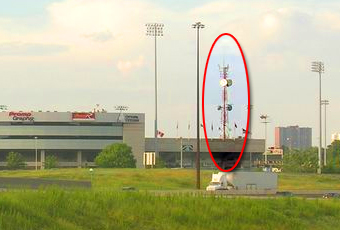 legs. legs.
The worksite accident occurred in the area of Lola Avenue and Coventry Road near the Ottawa Stadium just before 5 p.m., according to paramedics, who said they arrived on scene within three minutes and treated the man before transferring him to the Ottawa Hospital's Trauma Unit.
"He was awake and speaking with paramedics throughout," said Ottawa Paramedics Supt. Steven Leu, adding that the man is in stable condition.
Leu said the man lost his footing and the "fall arresting device" malfunctioned. He landed on his hands and feet, he said.
Ottawa police and the Ministry of Labour are investigating the accident.
A number of Canadians alerted WirelessEstimator.com to the accident in an effort to continue to identify how their tower climbers' safety record stacks up against other countries.
.
|
Michigan tower standard available for reference
 August 20, 2009 - WirelessEstimator.com has added the Michigan Occupational Safety and Health Administration's new safety standard for the construction of communications towers on its site for easy reference. The standard went into effect in April. Select Industry Standards on the main menu bar above and then Safety Standards. You'll also find the North Carolina Standard as well as a wealth of information about TIA/EIA 222-G. August 20, 2009 - WirelessEstimator.com has added the Michigan Occupational Safety and Health Administration's new safety standard for the construction of communications towers on its site for easy reference. The standard went into effect in April. Select Industry Standards on the main menu bar above and then Safety Standards. You'll also find the North Carolina Standard as well as a wealth of information about TIA/EIA 222-G. |
Canada and the UK enjoy enviable safety records
Schedule and margin pressures seen as possible reasons for higher death count of techs in the US
By Craig Lekutis
August 14, 2009 - The head of the Occupational Safety and Health Administration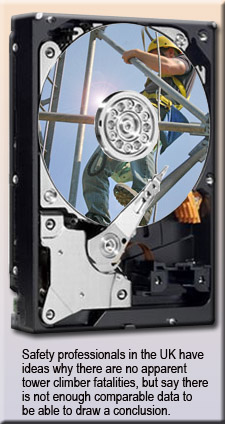 last year said that communications tower climbers had the highest fatality rate per 100,000 workers compared to other professions in the US. last year said that communications tower climbers had the highest fatality rate per 100,000 workers compared to other professions in the US.
Former Assistant Secretary of Labor Edwin G. Foulke Jr.'s statement didn't come as a surprise to the National Association of Tower Erectors, WirelessEstimator.com and others who have been tracking jobsite death data for a number of years.
Consequently, a shot from the hypothetical hip would indicate that working aloft on communications structures has to be the world's most dangerous job.
Not necessarily so, say academics, consultants, government safety officials, and tower erectors from other countries. The validity of such a claim is also argued by representatives from third world nations where a harness and steel-toed boots are optional if the climber is more comfortable with a hemp positioning rope tied around his shirtless midriff as he uses his bare feet as a sensory probe for sure footing.
In actuality, state some international industry professionals, the US's historical fatality rates far exceed - percentage-wise - those in countries where safe working practices have minimized deaths or kept them at zero for many years such as in the Great Britain where a safety and health official found no deaths for a number of years.
Some countries are notably proud of their safety record such as Canada where tower erection and maintenance company workers believe that their higher set of standards is one reason for a perceived lower fatality rate.
What began as research in 2008 as to how Canadian tower climbers weathered sub-zero temperatures evolved in an ongoing study through dozens of interviews and hundreds of emails of how other countries governed climber safety and whether or not it resulted in reduced rigger fatalities.
Please see: Research is oftentimes unavailable in e-search
Read: Viewers' Comments
|
NATE/OSHA partners improve safety by 40%
August 12, 2009 - A recent NATE/OSHA Partnership study indicates a 40% decrease in the year-over-year accident incidence rates for participants.
Further, the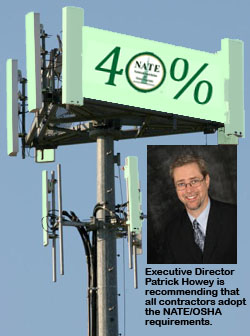 study shared statistics regarding the enhanced safety initiatives implemented by the National Association of Tower Erectors, the Occupational Health and Safety Administration and partner companies, including: developing and actively engaging in industry-specific training and voluntary tower-site audits. study shared statistics regarding the enhanced safety initiatives implemented by the National Association of Tower Erectors, the Occupational Health and Safety Administration and partner companies, including: developing and actively engaging in industry-specific training and voluntary tower-site audits.
The partnership's efforts to enhance safety awareness at all levels of the communications tower industry have achieved great success, according to NATE Executive Director Patrick Howey.
The NATE/OSHA Partnership is a voluntary safety initiative developed jointly by NATE and OSHA.
Participants must agree to extensive training, implementation of best work practices and safety and health management systems, and compliance with OSHA standards and regulations.
"The NATE/OSHA Partnership is composed of companies who are dedicated to a higher-level of safety," said Howey.
"Given these results, it seems clear that it is in the best interest of tower owner and operator companies to hire NATE/OSHA Partners. We strongly encourage more NATE member companies to join the partnership, increasing the pool of qualified contractors and protecting the lives of crews."
The 89 NATE/OSHA Strategic Partnership companies, which employ nearly 4,000 individuals, four times the number covered during the first year of the partnership during 2007, are seen as the elite within the tower industry, Howey said.
A record 127 tower industry companies applied for membership in 2009. Inductees will be announced this fall.
|
Highlights from the 2008 NATE/OSHA Partnership include:
-- Total case incidence rate (TCIR) for participants decreased 40% from last year.
-- Days away restricted transfer (DART) rate for participants decreased 37% from the previous year.
-- The two-year average TCIR for participants was 14% below the 2007 Bureau of Labor Statistics (BLS) average for the tower erection industry.
-- Over 1,300 self-inspections were conducted during this evaluation period, resulting in 350 hazards being identified and avoided.
-- NATE and OSHA developed industry-specific training courses and offered almost 50,000 hours of training (more than twice that of the first year), with 1,040 employees participating in the OSHA 10-hour course and 448 employees participating in the OSHA 30-hour course.
|
Sleeping tower worker wasn't at Motel 6 although officers left their patrol car lights on for him
August 7, 2009 - An Altamonte Springs, Fl. tower technician had an unorthodox wake-up call Wednesday morning when he was buzzed awake by a Seminole County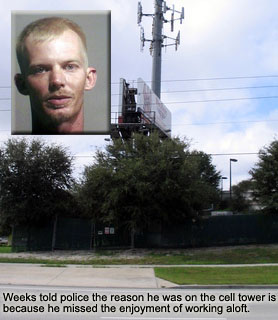 Sheriff's Office helicopter, patrol car sirens and officers yelling for him to get up through their vehicles' loudspeakers. Sheriff's Office helicopter, patrol car sirens and officers yelling for him to get up through their vehicles' loudspeakers.
A nearby San Sebastian Heights Apartments security guard had called police after he heard banging noises and then saw a man laying on an 88-foot monopole's platform located behind a Babies R Us store in the busy 700 block of W. State Road 436 in Altamonte Springs.
When officers arrived at the AT&T tower site they could see a man lying on a platform near the top of the tower. He was not moving and didn't react when officers repeatedly asked him to respond to them if he could.
Because they could see that he was wearing a fall protection harness and tool pouches, officers worried that the man was a tower technician who had been knocked unconscious.
But then Michael David Weeks, 29, sat up, looked at the entourage of emergency personnel below him, the helicopter above him, and realized that it was time to get up - rather get down - and climbed down the step bolts.
"He said he used to work on cell towers and missed it," said Officer Timothy Hyers of the Altamonte Springs Police Department.
Instead of a being handed a scope of work, Weeks was charged with trespassing and disorderly intoxication. Bail was set at $351.50. Weeks is listed as unemployed on jail records.
The monopole is surrounded by a 10-foot fence, topped with barbed wire. There are "No Trespassing" signs all around the property. Weeks told officers he knew the combination because he used to work on the tower, according to an arrest affidavit.
But officers said the combination he gave them did not work. Instead, they said, it appears the bottom of the gate had been pulled apart.
When asked if he had been drinking, Weeks said, "Yes, I'm intoxicated," according to the arresting officer's report.
|
Q3 seen as worst ever for some as AT&T and
T-Mobile national builds tank
July 29, 2009 - Companies that hitched their wagons to a star carrier or two found their earnings to be less than stellar this month and Q3 might prove to be their 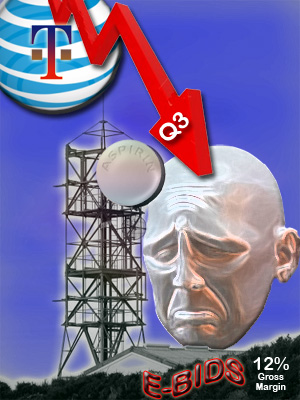 worst third quarter ever. worst third quarter ever.
Many other firms that did not allow one client to provide more than 25% of their income say that they're having an excellent quarter and are looking to hire additional workers to meet the demand.
The slowdown - and in some markets a standstill - of AT&T and T-Mobile projects has some contractors concerned about their viability to continue operations in an environment that is requiring them to bid many projects at cost.
Thinning margins, feast or famine carrier cycles, and staffing problems are causing many contractors to consider other business opportunities or search out alternative clients.
A number of smaller installation contractors closed their doors this month, according to accessory manufacturers who are chasing debts for co-location products.
However, being fully funded, politically entrenched and staffed with talent, doesn't ensure success as Becon Construction demonstrated recently as they announced next month's closing of their last telecommunications business unit in Baltimore, Md. They will be laying off approximately 80 land acquisition, management and field service employees.
In 2005, Becon's Industrial Relations Manager, De'Ann Eubanks, unabashedly flooded every available Yahoo tower group and other employment venues with worker solicitations, emphasizing above average salaries and company perks.
Her tenacity and benefit offerings were successful in quickly building one of the nation's largest telecom service organizations with of over 300 field service employees. Please see: Becon be-gone
|
Unauthorized climber attached to WSBT tower
July 28, 2009 - A 42-year-old South Bend, Indiana man is undergoing a mental evaluation after a standoff with police. Steven Lowel climbed WSBT's transmitter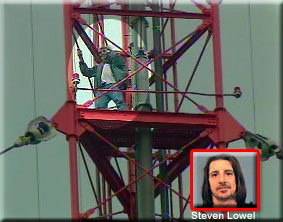 tower on South Bend's far south side this morning. tower on South Bend's far south side this morning.
He called a friend and told her, "I'm sorry. I'm so lonely. Everything's going wrong. Nothing's good."
Lowel was 400 feet off the ground on the tower when police arrived. The structure's overall height is 1,000 feet. He threatened to jump or possibly commit suicide by police.
His friend said he had a lot of issues in the past - including being admitted to a mental hospital when he was younger. She also said Lowel has battled a drug problem and just got out of a week of rehab last Friday.
"We were afraid his cell phone battery was going to lose its charge and we were going to end up losing communication with him," said South Bend Police Capt. Phil Trent.
Authorities also thought Lowel could have a gun. Police were not going up to get him.
More than four hours after he first climbed up, Lowel slowly made his way back down.
Along with Lowel's record of mental illness, he also has a history of attachment to the WSBT tower. St. Joseph County Police records show he climbed to the same spot almost 20 years ago, on August 12, 1989.
A WSBT engineer carefully watched the incident to ensure that Lowel did not climb any higher. If he did, the station's management was ready to reduce or shut off the power to their antenna so that Lowel wouldn't be injured.
|
Monopole sculpture is in the style of a
home-brew high industrial fruitcake
July 27, 2009 - After viewing a number of new sculptures, it would be tempting to lead with: "What do you get when you have marketing involved in the design of a wireless…", but that would be less than courteous to artist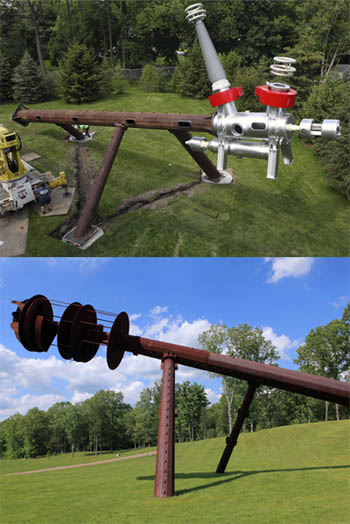 and Yale Professor Emeritus Edward Tufte, who has been compared to Leonardo da Vinci by the New York Times. and Yale Professor Emeritus Edward Tufte, who has been compared to Leonardo da Vinci by the New York Times.
Tufte recently installed his new sculpture (top photo) Rocket Science #2 (Lunar Lander) at the Aldrich Contemporary Art Museum in Ridgefield, CT for his show, Seeing Around, through January 17, 2010.
The celebrated artist said the piece is in the style of Home-Brew High Industrial Fruitcake. The 70-foot-long sculpture is premised, at least in part, on his specialized research in how we think.
"Many people nowadays do almost all their visual reasoning and analytical thinking while staring at the glowing rectangles of flatland computer screens," says Tufte.
"I'm trying to suggest ways of seeing effectively in spaceland and time that are as intense as the seeing now done largely on flatland screens," Tufte explained.
The museum is currently presenting the first exhibition of Tufte's three-dimensional works, including 18 immense outdoor installation pieces, a number of them done with monopoles, some of which might have been surplus left over from the days when AT&T's fixed wireless project imploded - a textbook example of: "What do you get when you have marketing involved in the design of a wireless…".
|
Chinese erector believes third time will be the charm following TV tower's collapse
July 27, 2009 - What was destined to become a landmark - a 615' self supporting TV tower, located in Jinzhou City in Northern China's Hebei Province -- partially collapsed last Thursday following a thunderstorm with winds clocked in excess of 75-miles per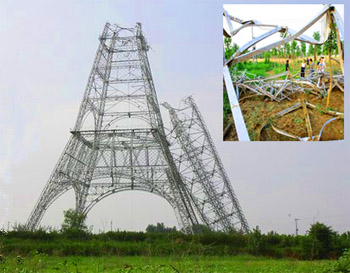 hour. hour.
Witnesses informed local media that they heard loud cracking sounds at about 7:00 p.m. and saw the tower swaying for about 10 minutes before it lurched and collapsed, breaking at the 184' and 230' levels.
The city's radio and television bureau had signed a contract with the Hebei Communication Equipment Factory in mid-October 2007, to finish building the tower in mid-February 2008. The city invested $468,000 in the construction of the tower, which was supposed to have a lifespan of 50 years.
But the work had been delayed long after the four-month building schedule had ended because of repairs that had to be made. The city government said strong winds had caused the top part of the tower to dislocate in April, after which the construction company had to perform repair work.
The city's tower erector said they were going to remove the broken sections and rebuild the structure.
|
OSHA investigating procedures and equipment of Colorado company following injuries to two techs
July 27, 2009 - A spokesperson for OSHA's Denver, Colo. area office said on Monday that they are continuing to investigate the procedures and equipment used by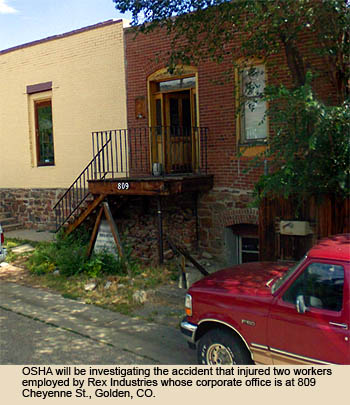 a Golden tower maintenance company to identify if the firm was complying with appropriate standards when two men were seriously injured when they fell while being hoisted to their work area. a Golden tower maintenance company to identify if the firm was complying with appropriate standards when two men were seriously injured when they fell while being hoisted to their work area.
It could be a number of weeks before any findings can be released regarding the accident that injured Charles Lovell, 48, and 24-year-old Peder Mork on July 20 when a load line became loose and they fell approximately 25-feet off a 1,162-foot Clear Channel tower in Greeley, according to the OSHA team leader.
Weld County Sheriff's Deputy Brian Spencer said that William Rex, owner of Rex Industries, said he was on the tower at about the 30-foot level just above Lovell and Mork who were being winched to their work area when they suddenly fell.
Thomas Wiltse, who was operating the hoist, said that the wire rope ran out of the spool and they fell.
"It happened so fast, I had no idea it was out," Wiltse said, according to Spencer.
OSHA requires that there must be at least three full wraps of wire rope on the hoist drum when personnel are being hoisted.
Rex said that the spool should have been watched by Wiltse and stopped when it got short on line, but the operator wasn't paying attention.
Wiltse told Spencer that he didn't realize it was out of cable. He said he heard something and "the cable went flying out of the winch and zipping across the air."
Spencer said he observed between 300 to 400 feet of cable on the ground.
At the time of the accident it was not known by authorities whether the hoist was man-rated and met the requirements for lifting employees.
Up until March of 2002, OSHA prohibited personnel from riding the line to their work station if it was located below 200 feet. The compliance directive was changed and the current OSHA Directive provides instructions to tower erectors regarding riding the line. It also identifies personnel lifting hoist requirements for design, construction, installation, testing, inspection, maintenance, modification, repair and operations.
OSHA will be using the directive to identify whether Rex Industries' equipment and personnel lifting procedures were in compliance.
|
Workers survive 30-foot fall from Colorado tower
July 21, 2009 - Two Denver tower workers were seriously injured after they fell 30 feet from a tower in Greeley, Colo., while doing work for Clear Channel yesterday afternoon,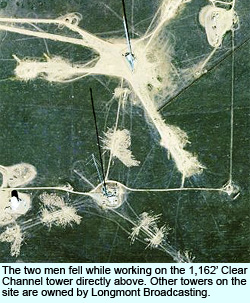 authorities said. authorities said.
Both men suffered ankle, leg and back injuries, according to Weld County Sheriff John B. Cooke.
Charles Lovell, 48, and 24-year-old Peder Mork were airlifted to Denver hospitals.
The men were suspended above the ground from a winch cable that was attached to the tower above them, but it failed and the two technicians fell to the concrete below at 2:30 p.m.
Authorities were unable to immediately provide the company's name that Lovell and Mork worked for or if the winch was man-rated.
The 1,162-foot tower is located near Highway 52 and Weld County Road 17.
|
A good prayer and a lanyard come through
July 21, 2009 - An Aniston, Alabama man is convinced about the positive power of prayer and fall protection equipment after a near death experience this morning.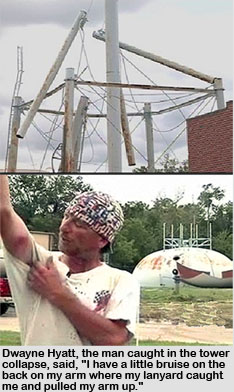
Dwayne Wyatt, an employee of Allstate Tower, Inc. of Henderson, Kentucky was helping to fell an unused water tower that was previously used for communications antennas in Sulphur, Louisiana.
According to Sulphur Fire Department District Chief Matt Frey, Wyatt, was on the northwest leg of the tower cutting away at a piece of the 40-year-old structure, approximately 80 feet above the ground.
When a crane began to lift up a piece of the tower, another part of the tower broke loose starting a domino effect that knocked Wyatt loose along with other parts of the tower.
After swinging around like a "rag doll", according to an eyewitness, Wyatt fell, but his safety harness stopped him from making impact with the ground.
"I hope God takes care of me is what I was thinking. It happened so quickly, but then it seemed like it lasted forever with everything falling around me," Wyatt said.
A coworker was able to help Wyatt get back on the ground. Wyatt walked away with a few bruises and an abrasion on his right arm.
Some of the pieces of the tower that dislodged fell onto the northern part of the Sulphur Dry Cleaners' building and gazebo as well as onto a power line near the business.
|
Tower tech succumbs in Texas following fall
UPDATE July 20, 2009 -Visitation services for Lucas Tucker will be held Tuesday, July 21, from 5:00 p.m. until 8:00 p.m. at the Baumgardner Funeral Home, 212 N. Tarrant St., Crowley, TX.
A funeral service will be held at 10:00 a.m. on Wednesday, July 22 at the Crowley Cemetery located on the 100 block of N. Hampton St., Crowley.
_ _ _ _ _ _ _ _ _ _ _ _ _ _ _ _ _ _ _ _ _ _
July 18, 2009 - A tower technician working in De Kalb, TX was killed this afternoon after falling from a communications tower owned by AT&T Mobility at 640 Route 82.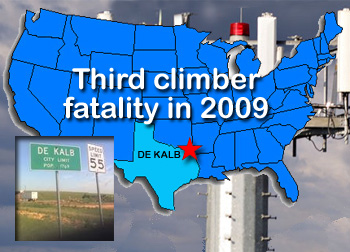
Lucas Tucker, 28, of Crowley, had been running transmission lines in snap-in hangers at approximately the100-foot level on the 337-foot guyed tower when he fell, reportedly hitting the structure's ice bridge.
A fellow worker on the three-man crew was approximately 20 feet below Tucker, but reportedly did not hear him raise his voice in distress as he brushed him on the way down.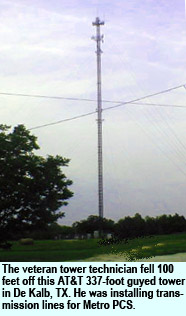
The accident happened at approximately 2:30 p.m. and De Kalb's emergency medical personnel were at the tower site within minutes. Tucker was pronounced dead at the scene.
He was employed by Lariat Communications, a subcontractor that was hired to install a Metro PCS co-location. The Burleson, TX company is owned by Ralph Hines.
Tucker, who had more than ten years of experience in climbing, is survived by his parents as well as two brothers who also work in the industry.
Tucker was the third worker killed this year after falling from a communications structure while performing professional services for a client.
Services are expected to be announced on Monday. OSHA is investigating the fatality.
De Kalb is a small Texas community of less than 1,800 people located 35 miles west of Texarkana.
|
How to cut into the broadband stimulus pie webinar being presented by PCIA and DAS Forum
July 20, 2009 - On July 1, the U.S. Department of Agriculture and Department of Commerce issued a joint Notification of Funds Availability and solicitation of applications for the $7.2B in economic stimulus funds appropriated under the American Recovery and Reinvestment Act for broadband deployment. applications for the $7.2B in economic stimulus funds appropriated under the American Recovery and Reinvestment Act for broadband deployment.
On July 23 at 1:00 p.m. EDT, The DAS Forum and PCIA will provide an overview of the NOFA and rules governing the funds' disbursement, particularly as it relates to wireless infrastructure.
The webinar will also address ways to improve your chances of securing funds and other important points, including funding paths for rural projects, non-discrimination and network interconnection obligations, the Buy American provision, organizational capability and readiness, teaming agreements with small and disadvantaged businesses, matching funding requirements, environmental impact, and project viability and sustainability.
Reserve your Webinar seat here.
Date: Thursday, July 23, 2009
Time: 1:00 PM - 2:30 PM EDT
After registering you will receive a confirmation email containing information about joining the Webinar.
|
Motorola job delayed by Molotov-type devices
July 16, 2009 - Project managers are used to a myriad of reasons why a crew wasn't able to be at the job site on time, but it's doubtful that this one resonates with the industry: I can't be there until the bomb squad releases my truck.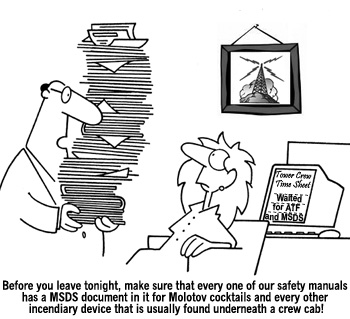
However, for workers employed by United Tower Company, this was not a dog ate my homework ruse, but a real incident that took place on Monday.
A tower technician told police in Chattanooga, Tennessee that he found some explosive devices under a work truck. Authorities said the incident happened at the Best Western Inn on Lee Highway.
Jason Simpson of United Tower said the firm was in Chattanooga doing a job for Motorola. He said they stayed at the motel for the night.
However, in the morning, technician Carlis Moore spotted two Coke bottles full of gasoline under the truck after he observed that some of the gasoline had spilled on the pavement.
The ATF and the city bomb squad were brought in to check out the devices and remove them.
Simpson said he did not know of any conflicts the company or the workers had or who could have placed the devices.
|
Two Radio Disney towers taken out by fire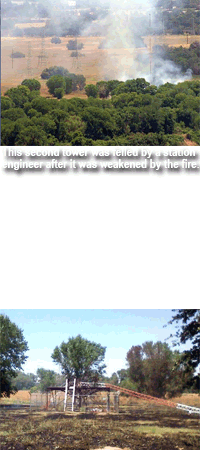
July 15, 2009 -- A two-alarm wild fire this afternoon toppled a 250-feet radio tower along the American River Parkway, damaged a second one and threatened a third, fire officials said. The fire, near Commerce Circle and Lathrop Way in North Sacramento, Calif. was reported shortly before noon, according to a Sacramento Fire Department news release.
No injuries were reported, fire officials said. The fire destroyed a small building that housed radio equipment at the base of the collapsed tower.
ABC Radio, which broadcasts Radio Disney to the Sacramento area, owns the three tower AM array. Fire investigators are looking into whether "something electrical" inside the building caused the fire, but have not yet determined a cause.
About 35 firefighters, including some from Sacramento Metropolitan Fire District, fought the blaze in the heat. They also had difficulty accessing water back and forth from a nearby business park and had to use caution around one of the towers that was leaning over at the top.
A station engineer cut a guy wire with a bolt cutter and the second tower fell into an open field.
|
Mount Sutro tenant moves to the top
July 10, 2009 - The DTV transition on June 12 came and went without the catastrophic disruptions forecast by many politicians who championed the  later switchover date. later switchover date.
However, stations are still fielding some calls, most of them a result of homeowners unable to set up the converter box necessary to receive a station's signal on their analog set.
There are some areas in the country, however, where weakened coverage is causing viewers to be unable to tune in to their favorite stations.
Because of the Bay Area's hilly terrain and other obstacles in San Francisco, some viewers called CBS Channel 5's DTV hotline and reported that they could not get a picture.
Currently, Channel 5's digital signal is being transmitted from about a third of the way down the Mount Sutro tower. Workers are moving the digital equipment to the spires at the very top.
"It's a delicate job with a lot of heavy equipment, and potential for short disruptions," said Chief Engineer Michael Englehaupt.
"There will be occasions where we have to move to an auxiliary antenna. Some people who are otherwise receiving us fine may lose the picture, during the day," said Englehaupt.
But for many, explained a news release from Channel 5, their digital signal may be stronger and patience will pay off. The project should be finished in September.
|
Sprint Nextel and Ericsson ink $5 billion
seven-year management contract
July 9, 2009 - Following months of rumors, Sprint Nextel and Ericsson announced a seven-year outsourcing deal valued at up to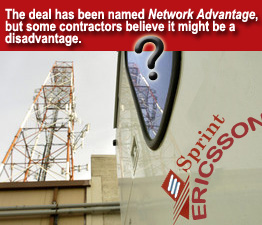 $5 billion and involving 6,000 Sprint employees. $5 billion and involving 6,000 Sprint employees.
Under the agreement, Ericsson assumes responsibility for the day-to-day services, provisioning and maintenance of Sprint's CDMA, iDEN and wireline networks. In the announcement, Sprint made it clear that it "retains full ownership and control of its network assets, and solely owns network strategy and investment decisions."
And, presumably to highlight the enormity of the agreement, the companies gave a name to the deal: "Network Advantage."
"No other U.S.-based carrier has followed through on the business-enhancing vision inherent in Network Advantage," said Sprint's Steve Elfman, president of network operations and wholesale. "Our best-ever network performance will become even better by leveraging Ericsson's world-class leadership in network services, their proprietary tools, and the knowledge of more than 30,000 dedicated and highly-specialized service professionals to power Sprint's Now Network."
Ericsson hasn't received a good report card from contractors working with them in the northeast on T-Mobile contracts.
"This has been a train wreck from day one," explained one contractor who cited equipment issues that are forcing his crews to return to sites without any compensation for remobilization.
Ericsson's closeout documentation requirements for T-Mobile work came under fire as well.
"It's a done deal," said one New Jersey contractor. "They've got it for the next five years, so you either decide to get married to them and make the best of it or get out of the game."
Verizon Wireless says it has no plans to follow Sprint Nextel's lead in outsourcing its network operations. "We have decided to run and operate our own networks and be directly responsible to our end customers," Verizon Wireless spokesman Jeff Nelson said.
|
Digital takes its toll on the UK's tallest structure with US taking back height, but not a safety record
July 9, 2009 - It doesn't have the allure of the Eiffel Tower or Canary Wharf, but the height of the 1,272-foot Belmont Tower in a remote Lincolnshire field in the UK, puts both of them to shame - at least for now.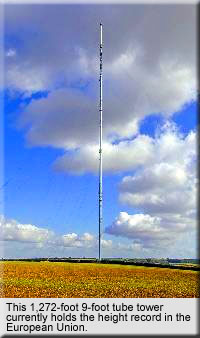
For 44 years, it has been the European Union's tallest tower, but that record will fade to black when a tower crew removes the top lattice 118-foot section when a new antenna is installed in the autumn for the switchover to digital TV.
This will hand the title to the American military's 1,214-foot Torreta de Guardamar radio mast in Spain and see Belmont relegated to a lowly 14th position. It will also lose the crown of Britain's tallest structure to the 1,197-foot TV transmitter in Skelton, Cumbria.
Three of the 9-foot-tube structure's 18 guy wires will be removed. Although it has an elevator, a gin pole or possibly a helicopter will be used in dismantling the top and setting the new antenna.
The DTV changeover is not required until 2011, but ample time is being provided for the work in case the weather forces delays.
It is expected that the exacting work will be a safe project, based upon the UK's enviable record of no climber fatalities in many years.
Although a number of people believe that the UK's seemingly better record than the US regarding fatalities of workers falling from a height is skewed, based upon the fewer number of towers, statistics paint a different picture.
A Crown Castle International executive recently echoed others who said that they believed that the UK's towers were considerably shorter in height and that might provide a corollary regarding the non-existent death rate. However, industry statistics identify that deaths can happen at any height exceeding six feet.
Last month, a ham operator was killed when he fell less than 30 feet.
WirelessEstimator.com will provide a detailed overview of international tower climber safety in an article on August 3. If you would like to add to the study based upon your knowledge of safety standards, fatalities and company practices outside of the US, contact us at info@wirelessestimator.com .
|
New Jersey tower technician tagged for multiple copper thefts in Pennsylvania
July 2, 2009 - Five days before a New Jersey tower tech, his girlfriend, and their accomplice were arrested on Monday night for allegedly stealing copper from an American Tower Corporation tower site in Eddystone, Pa., a neighbor took notice of a suspicious U-Haul van with Arizona plates.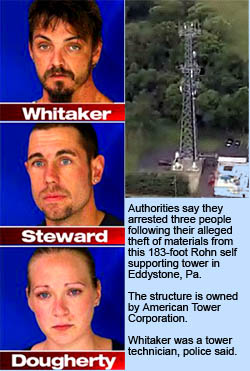
Yesterday afternoon, Delaware County District Attorney G. Michael Green announced the arrests of Shane Edward Whitaker, 34, of Williamstown, his girlfriend Kimberly Nicole Dougherty, 25, of Deptford, and their accomplice Kevin Edward Steward, 26, of Gibbstown - crediting Herb Wright of Eddystone and others for aiding in their apprehension.
Wright, the installation manager for Radio Communications Service, Inc. where the 183-foot Rohn self supporting tower is located, lives behind the Motorola two-radio shop at 640 Eddystone Avenue.
He told authorities he didn't think much of it when he first saw the U-haul van back up next to the tower last Wednesday, or when he saw it back the next night.
On Sunday, Wright said a fellow worker called him and told him that he saw a technician working about 130 feet atop the tower. But with multiple tower crews accessing the tower to serve its four tenants, he wasn't overly concerned.
Monday morning, he arrived at work to find cut cable wires, and equipment on the floor inside the tower. He then asked his children to watch the site and let him know if they saw a U-Haul anywhere close to the tower.
At 9:00 p.m., his son noticed the U-Haul next to the tower compound.
Wright was on the phone with police dispatchers when he saw neighbor Wayne Hunley in pursuit of the U-Haul.
Wright said Hunley later told him that he was dropping off a lawn mower at his mother-in-law's house by the tower and saw three people. When Hunley asked what they were doing, one of the males indicated he had a work order.
When Hunley asked to see the work order, Wright said the three people jumped inside the van and sped off. Police caught up their van and questioned the three occupants. Whitaker was wearing a safety harness at that time.
Since the arrests, Green said his office and other agencies, including the FBI, have been reaching out to jurisdictions in Pennsylvania and New Jersey, urging them to check towers for signs of tampering.
The three defendants are charged with theft by unlawful taking, receiving stolen property, criminal mischief, loitering and prowling at night and related offenses. All three are being held at the county prison in lieu of 10 percent of $150,000 bail.
Green said Whitaker had training in tower construction and was familiar with how to access equipment without causing harm to himself.
"We have reason to believe they did scale the tower," Green said.
Detectives are sifting through data from a GPS device found in the van to determine other towers that might have been vandalized, Green said.
|
NTIA/RUS release details on broadband
stimulus funds availble
July 1, 2009 - The Departments of Agriculture and Commerce has released details on how entities can apply for funds allocated for broadband grants, loans, and loan guarantees under the American Recovery and Reinvestment Act. The Notice of Funds Availability (NOFA) is available here and describes the procedures necessary for applying for stimulus money to fund broadband initiatives. guarantees under the American Recovery and Reinvestment Act. The Notice of Funds Availability (NOFA) is available here and describes the procedures necessary for applying for stimulus money to fund broadband initiatives.
The National Telecommunications and Information Administration, which is administering the Broadband Technology Opportunities Program portion of the funding, and the Rural Utilities Service, which is administering the Broadband Initiatives Program portion of the funding, have each released two page fact sheets on their programs which are available for download (BTOP Fact Sheet) and (Broadband Initiative Program) .
The government will allow private companies to bid for BTOP money and has defined broadband as 768 kbps downstream, 200kbps upstream, according to the just-released guidelines for broadband stimulus funds.
Definitions have been provided for the broadband infrastructure category - up to $1.2 billion - for funded projects that deliver broadband service through last mile or middle mile facilities to unserved and under served areas.
Unserved Area: An area composed of one or more contiguous census blocks where at least 90 percent of households in the proposed funded service area lack access to facilities-based, terrestrial broadband service, either fixed or mobile, at the minimum broadband speed.
Underserved Area: Last Mile Projects-an area composed of one or more contiguous census blocks where at least one of the following is met: 1) no more than 50 percent of households in the proposed funded service area have access to facilities-based, terrestrial broadband service at greater than the minimum broadband speed; 2) no fixed or mobile broadband service provider advertises broadband speeds of at least 3 Mbps downstream in the proposed funded service area; or 3) the rate of broadband subscribership for the proposed service area is 40 percent of households or less. Middle Mile Projects-an area composed of one or more contiguous census blocks where one interconnection point terminates in a census block area(s) that qualifies as unserved or underserved for Last Mile projects.
|

|
| |
| |
|